Are You Ready to Discover the Outer Hebrides’ Secrets?
Join us on an epic Outer Hebrides road trip. We travelled extensively through the Isles of Lewis and Harris, and our guide includes a 4-day itinerary filled with the best spots to visit, unique experiences, and practical tips for your Hebridean road trip.
Picture lunar-like landscapes, mythical standing stones, rugged shores, and white sandy beaches that almost beg for a hammock and a pina colada – if only the weather would play ball!
Let’s embark on this adventure together!
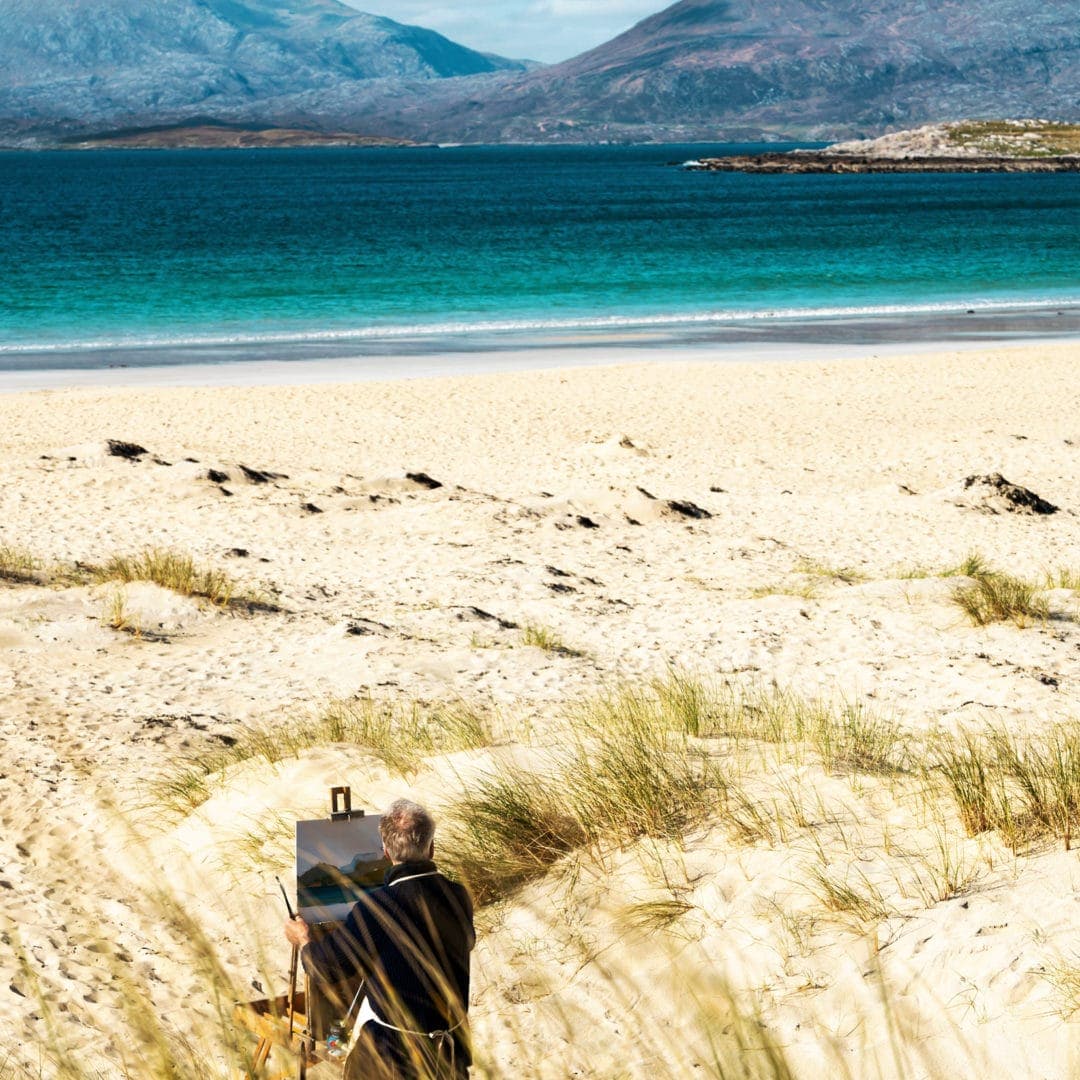
Planning a Trip to the Outer Hebrides?
- 🚗 Hiring a car? We recommend getting a quote from DiscoverCars
- 🚐 Hiring a campervan? We recommend Motorhome Republic
- ⛑ Arranged your travel insurance? Compare quotes from World Nomads & Safetywing
- 🪪 Order your International Driver’s Licence online here
- 🏩 Booked your accommodation? We use Booking.com to find the best deals
- 🐾 Is someone pet-sitting for you? 🐾 We use and love TrustedHousesitters
- (Get 25% off at checkout for new memberships with our discount code: LIFEJOURNEY25)
Outer Hebrides Map
This map is useful as an Outer Hebrides trip planner. You can download and save it when you visit the Outer Hebrides. All of the things to do on Lewis and Harris that we’ve included in this article are marked on the map.
We’ve colour-coded the suggested daily itinerary to help you plan a 4-day Outer Hebrides trip.
Visitor Tip: This Lewis and Harris itinerary can easily be extended to a five—or six-day tour of the Island.
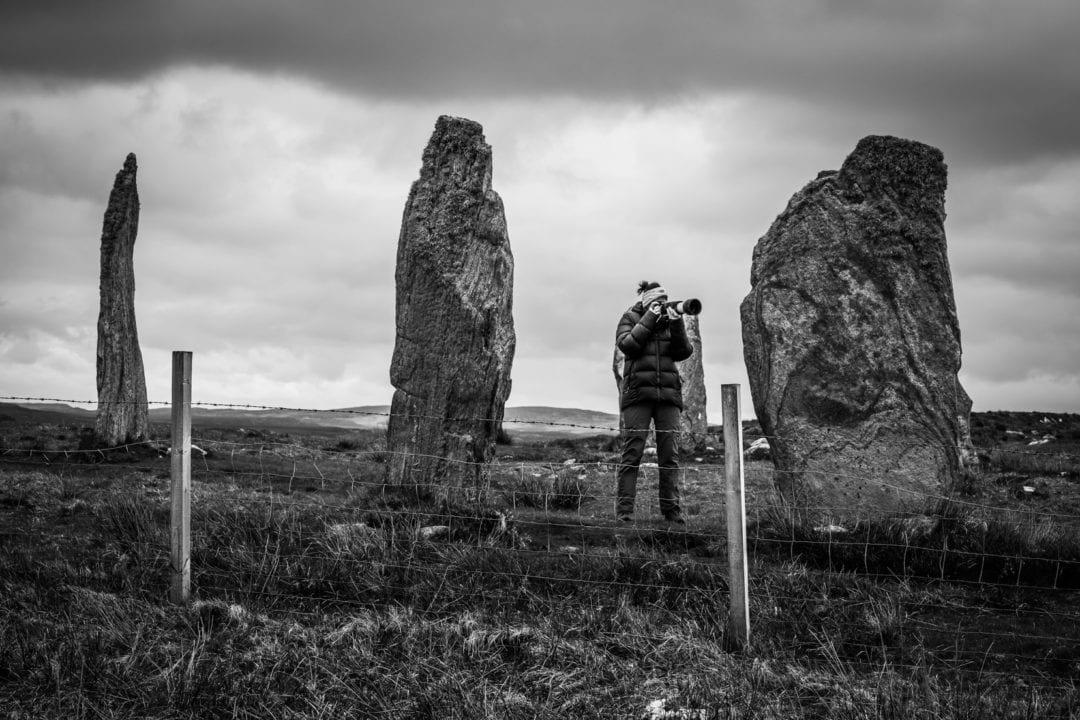
Planning Your Outer Hebrides Road Trip
This Outer Hebrides road trip focuses on the Isle of Harris and Lewis.
If you have longer than four or five days on the island, then you could venture further south and explore the southern Outer Hebrides islands, Uist and Barra.
We recommend spending at least a week in the Outer Hebrides if you plan on island hopping.
Four to five days was the perfect time to explore Lewis and Harris, but this same road trip itinerary could easily be spread over five, six or seven days. We did pack a lot in, so take five or six days for a slower-paced Outer Hebrides road trip.
You may also like to take a boat trip to the World Heritage island of St.Kilda, 40 miles off to the west.
It’s home to one million seabirds and the UK’s largest colony of Atlantic puffins. St Kilda has dual UNESCO World Heritage status for its cultural and natural significance.
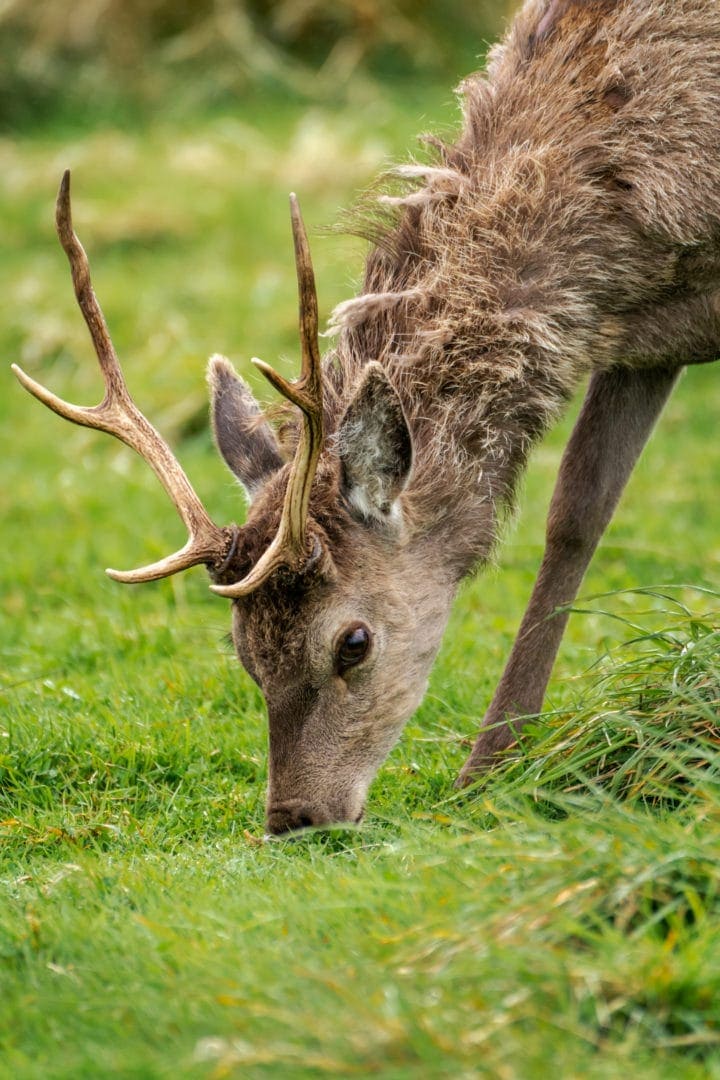
We arrived by ferry in Stornoway, the main town of the Outer Hebrides, and based ourselves in the same accommodation for the five days we were on the island.
The ease and relatively short distances to the attractions on the island meant we could have a ‘home base’, saving the hassle of packing up and moving during our Outer Hebrides road trip.
Arriving in Stornoway
As we sailed towards the port, my first glimpse of Stornoway from the ferry wasn’t what I was expecting.
Its industrial appearance was a shock.
I was expecting quaint, homely stone cottages surrounded by working crofts. However, the romanticism in my mind’s eye didn’t materialise. In reality, the majority of houses in Lewis and Harris are rendered with a drab grey/white pebble dash and lack any distinctive charm.
Nonetheless, the bewitching landscape and resplendent beaches more than make up for the lack of kerb appeal.
While passing through Stornoway, why not stop at the iCentre (tourist Centre) for a schedule of local events and brochures on your particular interests?
As you come off the ferry at Stornoway ferry terminal, you’ll pass a large Tesco supermarket, so can stock up on any supplies that you may need.
Note: Most shops and businesses are closed on Sunday (including Tesco)
Accommodation On Lewis and Harris
We planned our Outer Hebrides road trip for the start of May, and even though we were looking for accommodation six months prior to our arrival, many places were already booked.
Therefore, we recommend booking well in advance as accommodation is limited on the islands.
Our original plan was to travel through all of the Outer Hebrides islands, from south to north, but the lack of accommodation forced a change of plans.
In hindsight, deciding to limit our road trip to Lewis and Harris was the best way to spend our five days, giving us time to enjoy it all more thoroughly.
Our accommodation was excellent, and we can’t recommend it highly enough.
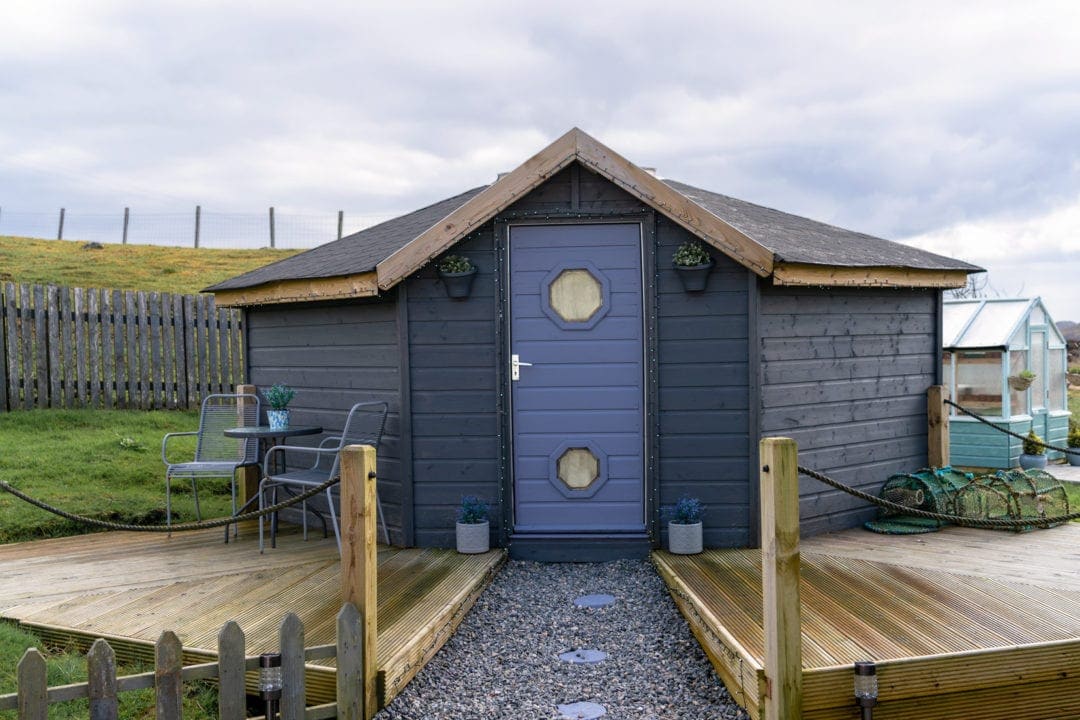
The Yurt@Ranish is a wonderfully peaceful space with a modern and cosy interior. It’s kitted out with a small kitchen hob, microwave, fridge, toilet, shower, TV and free wifi. A perspex skylight lets you star gaze from the comfy double bed.
It’s no surprise that the accommodation gets five-star reviews.
Claire and Paul are the super hosts for this tiny home, which sits in the garden behind their house. The Yurt is like a tardis; it’s so much bigger inside than it looks from the outside.
If the Yurt@Rannish isn’t available, check other Outer Hebrides accommodation on Booking.com here.
These have exceptional ratings on Booking.com:
🛏 Sundown Cottages, Isle of Lewis
⭐️ 9/10 “Beautifully located accommodation with fantastic views, very well situated to explore both Harris and Lewis; Christine is a great host who helped us at all times with tips and information, we were completely satisfied”
— Denis (Germany) Jan 2023
🛏 Anhain Cottage, Isle of Lewis
⭐️ 10/10 “An absolute delight to stay here. The house was immaculate and so well stocked. From kitchen utensils and sauces to little extras like dressing gowns and room sprays. On top of that, the hosts were incredibly lovely and helpful.”
— Beth (UK) 2022
⭐️ 10/10 “This place has a stunning location, excellent facilities and a wonderful welcome. Ideal base for exploring this wonderful place and a great place to return to at the end of a long day to relax and look endlessly out of those amazing windows”
— Joan (UK) 2022
Best Time to Visit Outer Hebrides
The best time to visit the Outer Hebrides is between April and October. Many services and attractions won’t be open outside of these times.
July and August tend to be the busiest months, so we would recommend May or September, the shoulder months where hopefully the weather isn’t too harsh but tourist numbers are lower too.
How to Get to The Outer Hebrides
Getting to the Outer Hebrides isn’t particularly cheap, but neither are many places worth visiting.
We caught the Calmac car ferry from Ullapool to Stornaway, across the stretch of water called the Minch, a two-and-a-half-hour trip.
When booking your ticket, you will need to pay for your vehicle in addition to an adult ticket:
For example, we paid £111.50 for the car and £20.50 for each of us — a total of £152.50.
You can buy tickets online here.
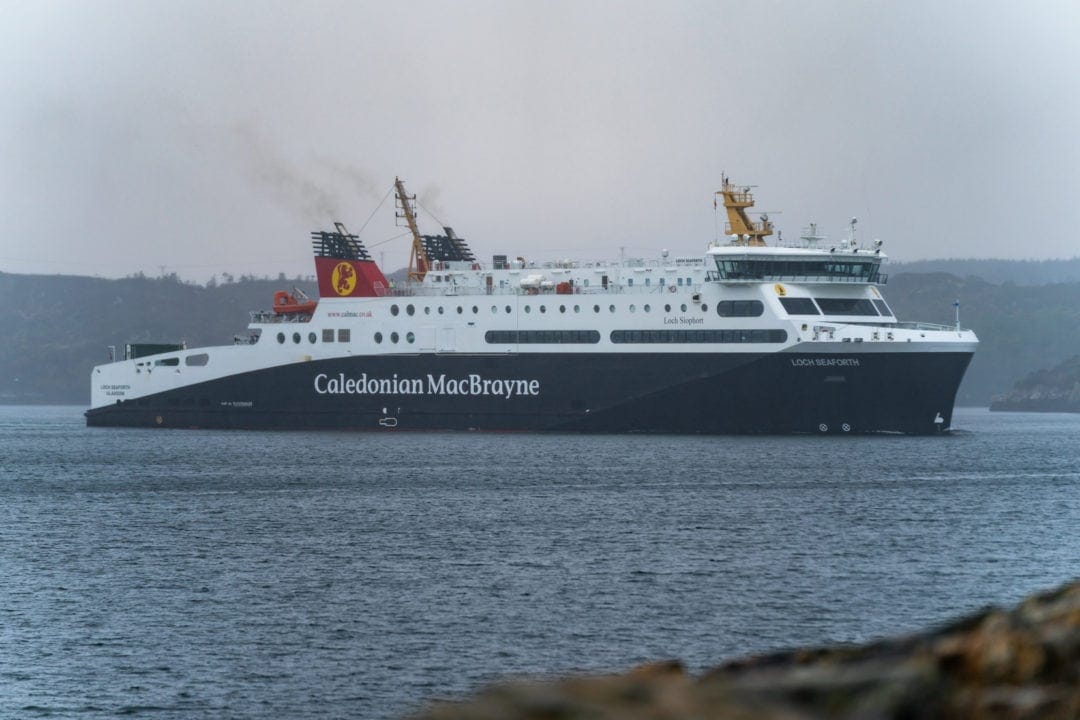
Calmac (Caledonian MacBrayne) run the western Isles ferry services between the island and the mainland as well as the services between the Outer Hebrides Islands.
You can take the ferry to the Outer Hebrides from the mainland at Ullapool, Uig on Skye, and Oban.
Another option for a road trip in the Outer Hebrides would be to fly to Stornaway and hire a car or a motorhome on the island.
🚘 If you want to hire a car, we recommend DiscoverCars.
WHY?
- They were winners of the World’s Best Car Rental Booking Website 2022.
- They find the best deal from over 500 rental companies
- They have a Price Match Guarantee.
- 4.5 Rating on Trustpilot
- Excellent Customer Service
- Free Cancellation
Logan Air runs direct flights to the Western Isles from Glasgow, Edinburgh, and Inverness.
Interestingly, Barra Airport’s (the most southern island of the Outer Hebrides) landing strip is on a beach, Traigh Mhor. Here, flight schedules are at the mercy of the tides. It’s been voted one of the world’s most scenic airport approaches.
Outer Hebrides Road Trip Itinerary
This road trip itinerary covers a four-day Outer Hebrides tour. But it’s easy to swap locations and days around, depending on the weather. For example, if the weather is fine, you may want to visit the Standing Stones at sunrise or sunset.
Alternatively, it’s probably best to visit the museums instead of the island’s gorgeous beaches if it’s pouring rain.
We’ve included all the best things to do on Lewis and Harris with a mix of landscapes, culture, history and wildlife.
Day One Outer Hebrides Itinerary: South Harris
- Golden Road Route in South Harris
- Seal Colony
- St Clements Church
- Sgarasta Mhor Beach
- Nisabost Beach – could walk from here to Mclouds stone
- Selibost Beach
- Luskentyre Beach
- Harris Monuments
The Golden Road
The Golden Road takes you on a lunar adventure. This single-lane road weaves its way along the east coast of South Harris.
Its zig-zag bends and winding paths force you into a slow meander across a landscape of lunar-like craggy rocks, sparkling lochs and spectacular views.
It’s named the Golden Road because the construction costs for the 21-mile route were enormous because of the difficult terrain.
Although narrow, it isn’t a busy road, and there are plenty of passing places if you do happen to meet oncoming traffic.
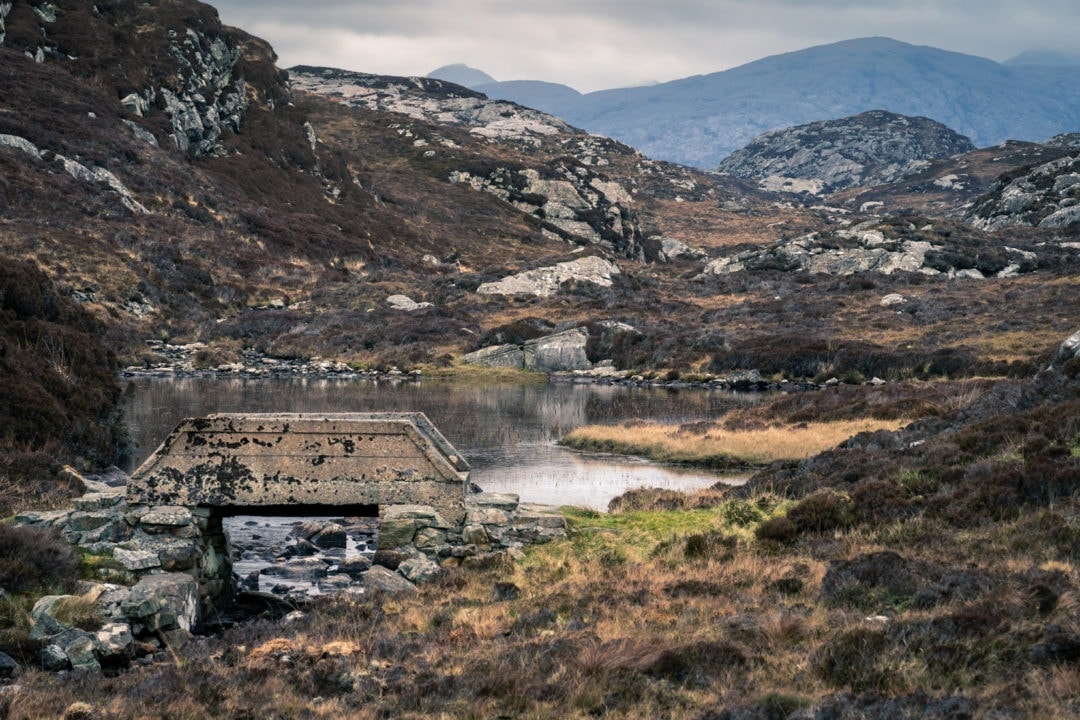
Join the Golden Road off the A859 (see map above). From here, follow the undulating tarmac artery that links tiny settlements with unpronounceable names dotted along the coast and amongst the lochs.
Gaelic is spoken by many in the Outer Hebrides, and some of the place names can seem unwieldy at best.
Along the way, you will encounter plenty of sheep, stunning views, blind bends, a seal colony and at the end of the road, at Rodal, the Hebrides medieval Church of St.Clements.
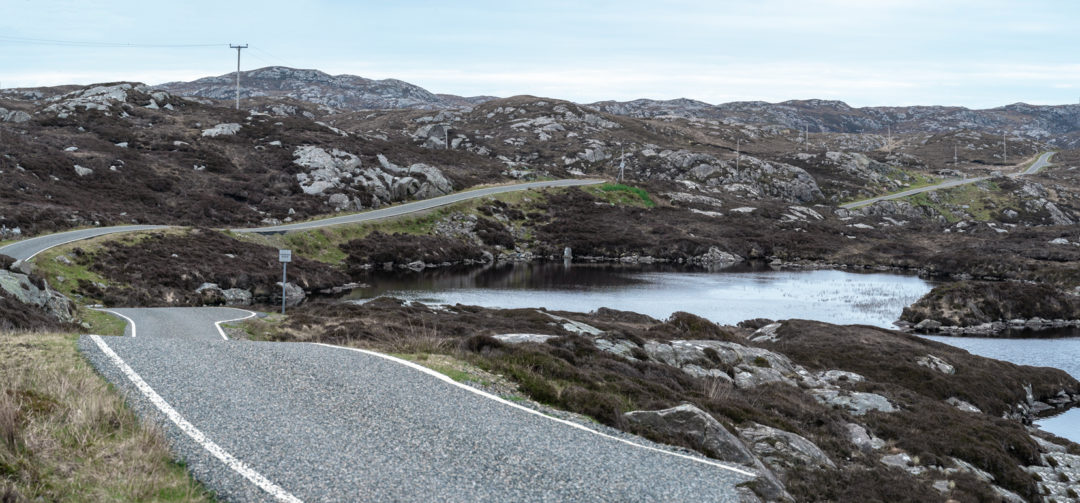
Seal Colony at Finsbay
The Golden Road weaves you in and out of many coves, but make sure you stop when you reach Finsbay (Fionsabhagh). Because here, you’ll come across a colony of about 50 harbour seals.
Pull off the road and park. About 100 meters from here, on a small rocky island, you’ll likely see the seals hauled out and resting on the rocks.
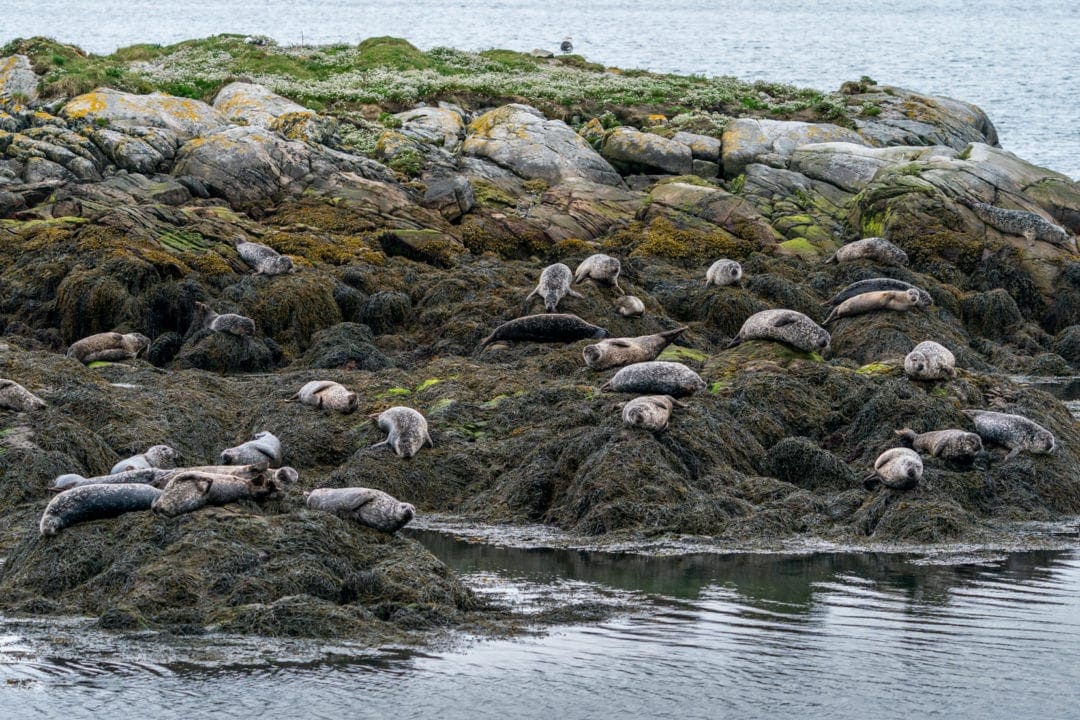
St Clements Church, Rodal
We wanted to visit St. Clements Church (Tur Chliamain), not only because it is said to ‘be the grandest medieval building in the Western Isles’, but because of the broken heart set in the stone wall.
The 8th Chief of Clan MacLeod, Alasdair MacLeod of Dunvegan, founded St Clements Church in about 1520. His impressive tomb inside the church has spectacular carvings above it, including a hunting scene and a rare representation of a sailing galley of the 1500s.
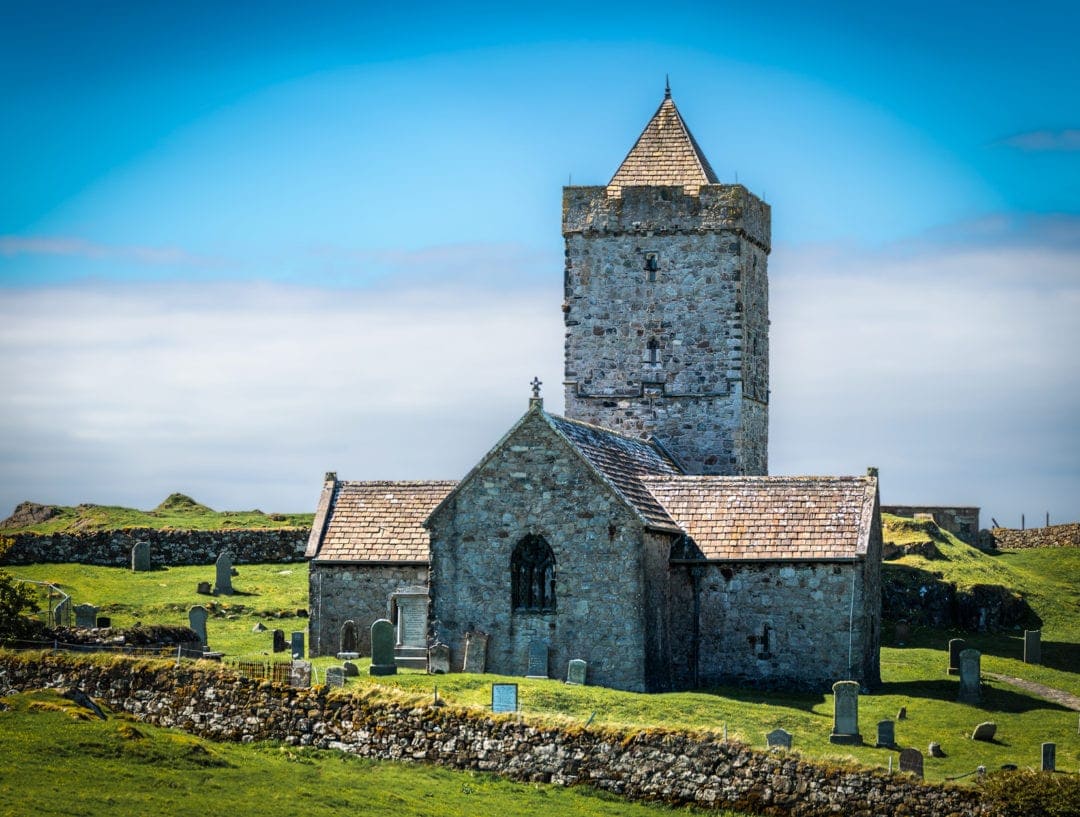
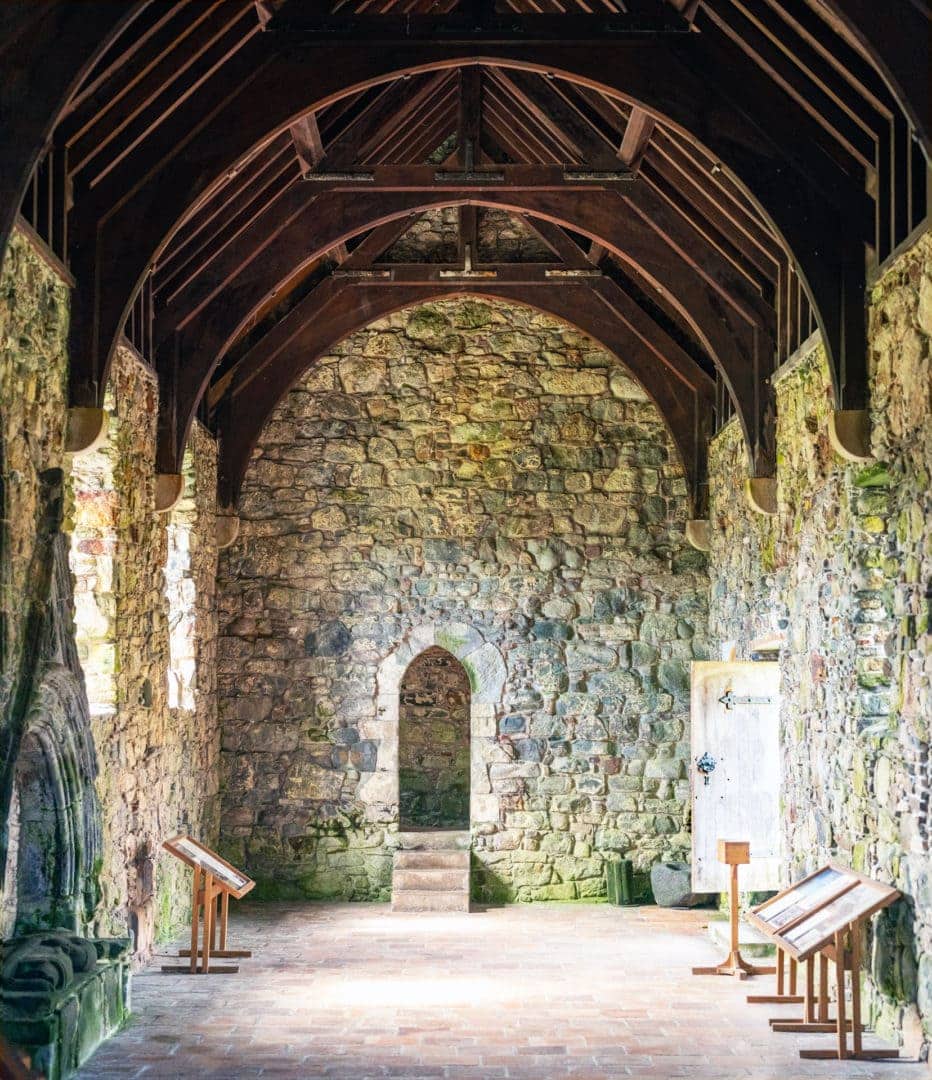
During its lifetime, the church has fallen into disrepair several times and burnt down, but each time was repaired, rebuilt and restored.
The tombs aren’t the only interesting carvings found at the church. On the outside of the church’s tower, you’ll find a Sheela Na Gig and a male exhibitionist stone carving known as “The Lewd Man”. A surprising sight on a church, but carvings such as these are found throughout Europe.
A Sheela Na Gig is a carving of a woman with exposed and/or exaggerated genitalia, usually found on religious buildings.
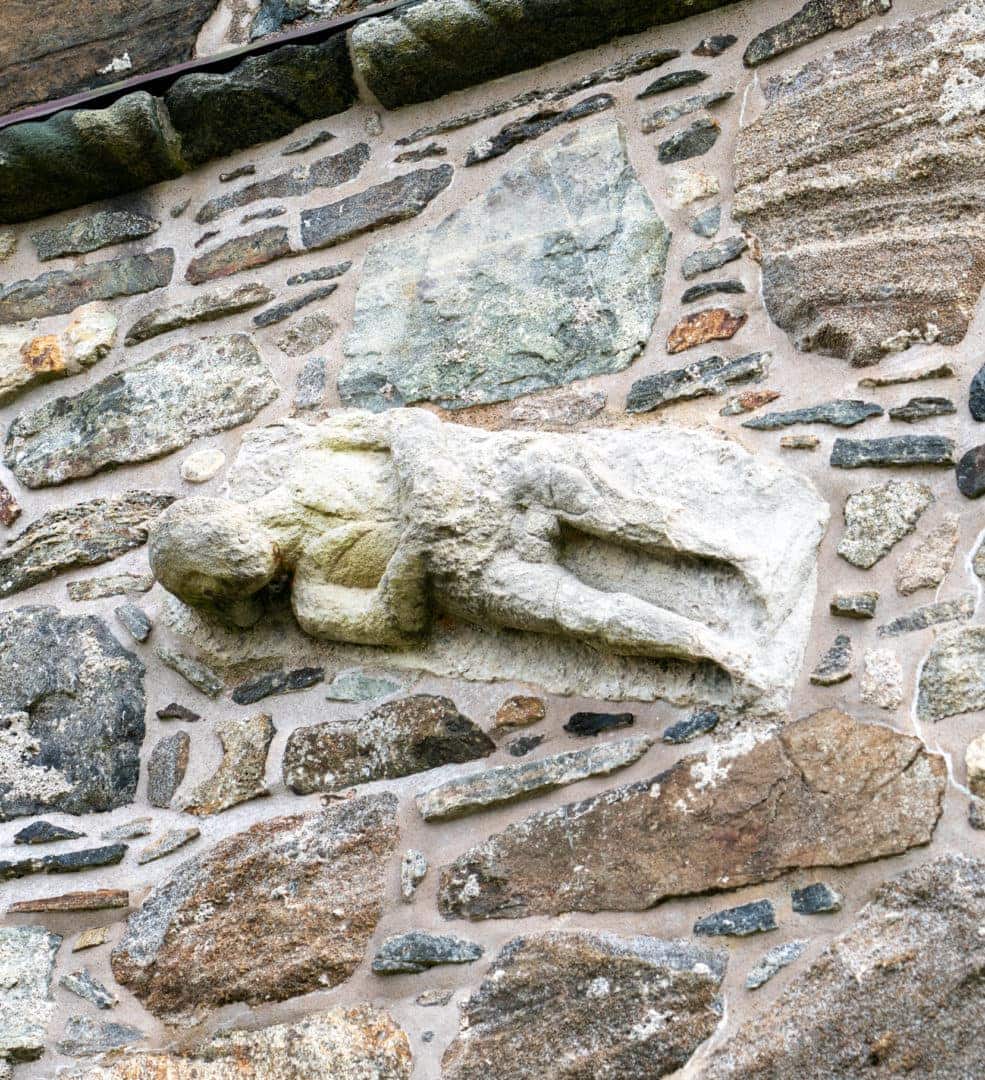
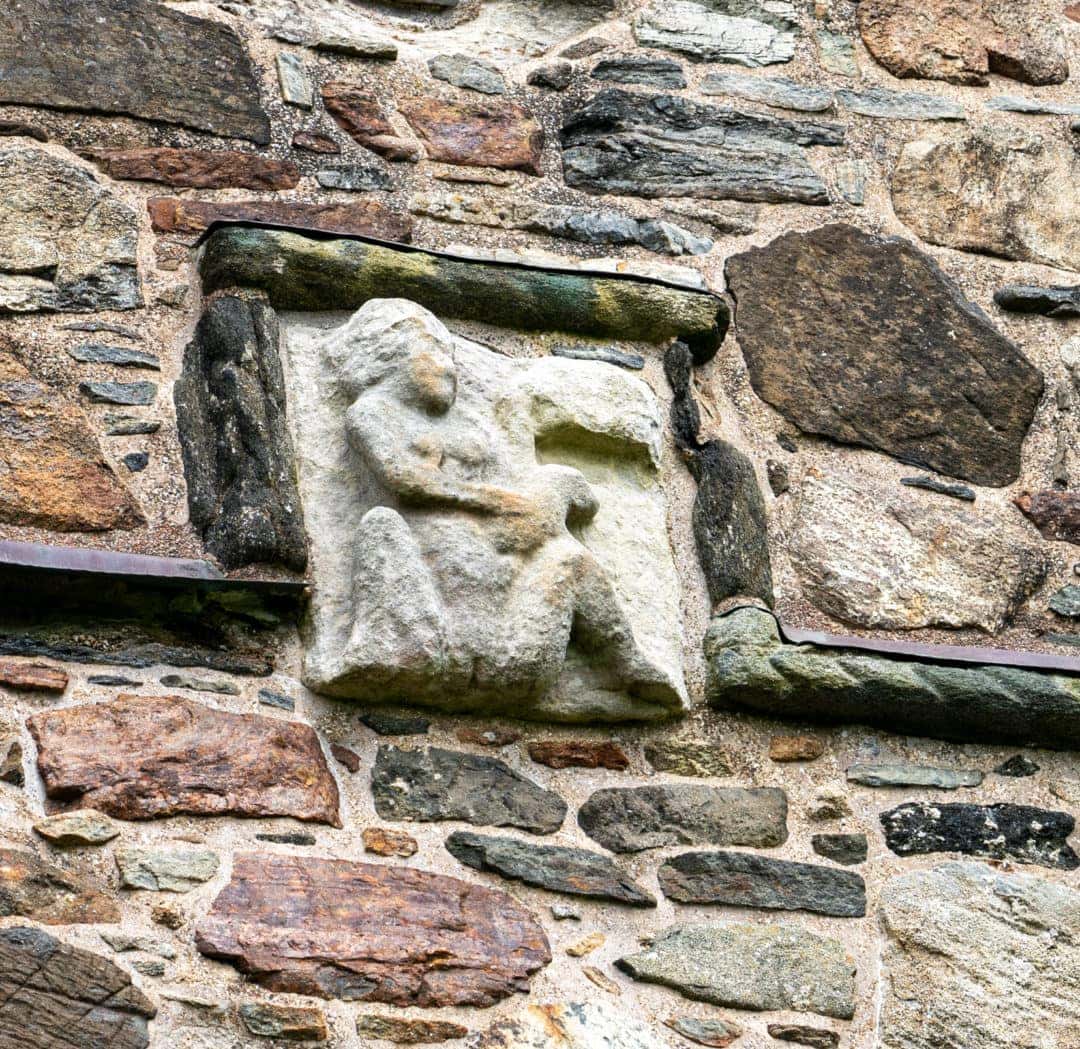
Apart from these stone carvings, my favourite stone has to be the broken heart on the outside wall of St Clement’s Church.
The heart-shaped stone, with a crack running through it, is said to have been placed there by a brokenhearted stonemason when he realised that the girl he had fallen in love with was already married and could never be his.
A stone flower is also built into the wall — see if you can find it, and this heart.
With salty sea air wafting in on the breeze, I wandered through the tombstones. I’m often surprised at how peaceful and calm graveyards leave me, and St Clements was no different.
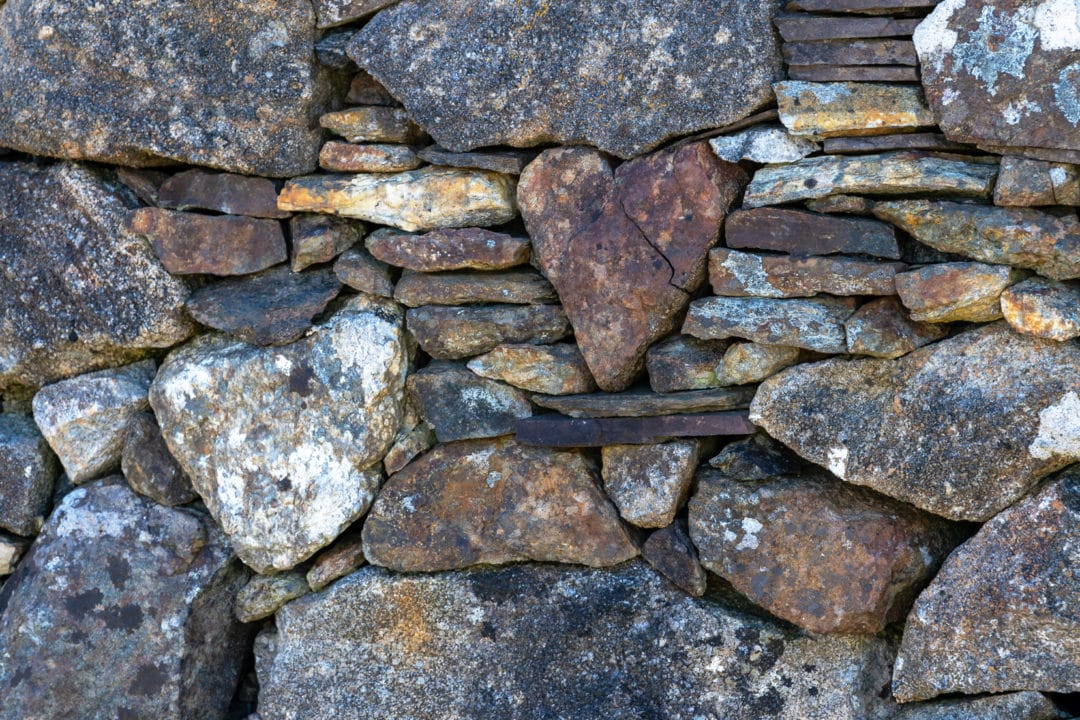
You can also visit this church as part of a day tour of Harris.
👉Check out all the available Isle of Harris and Isle of Skye Tours here
Western Harris Beaches
As you tour the Hebrides, you will come across the most beautiful beaches: white sand dunes with turquoise oceans lapping at their feet.
These are just a few along the western coast of Harris.
- Sgarasta Mhor Beach
- Nisabost Beach
- Selibost Beach
- Luskentyre Beach
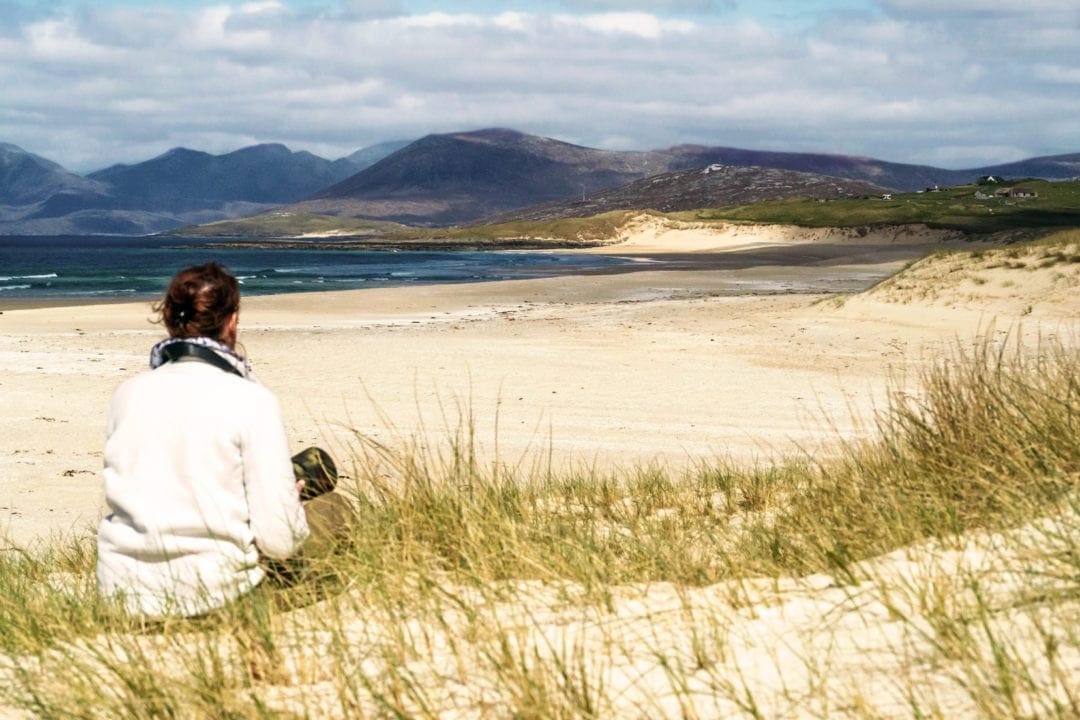
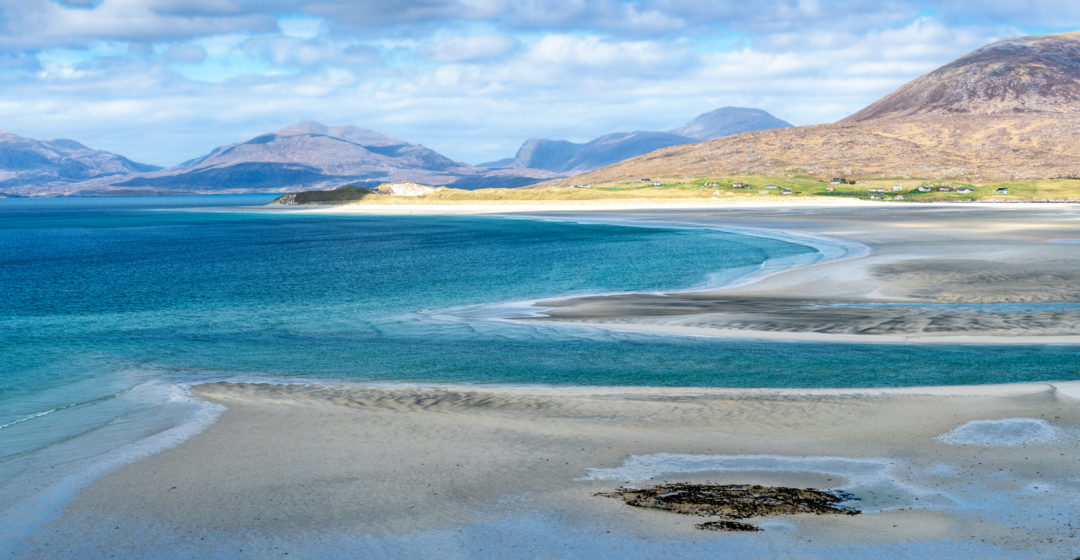
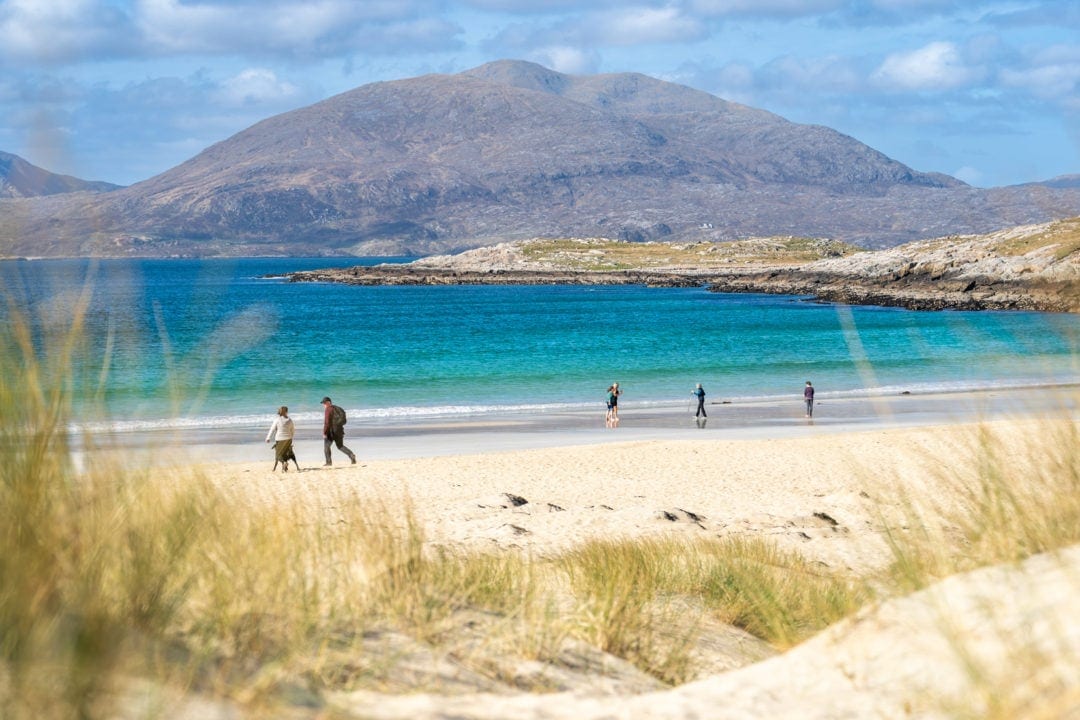
Lewis and Harris Monuments
On the A859 road heading north from Luskentyre, there are two monuments worth stopping to have a look at. Firstly, the monument standing on the site where Bonnie Prince Charlie landed on Lewis and Harris on 4th May 1746, after fleeing from the battle of Culloden.
A £30,000 bounty was put on his head, but the locals remained loyal and did not betray him.
Secondly, one of the Land Clearing monuments is on a hill to the left as you head north. A few of these stone cairn sculptures are found on Lewis and Harris, designed as memorials to the land struggles on the islands after the Highland Clearances.
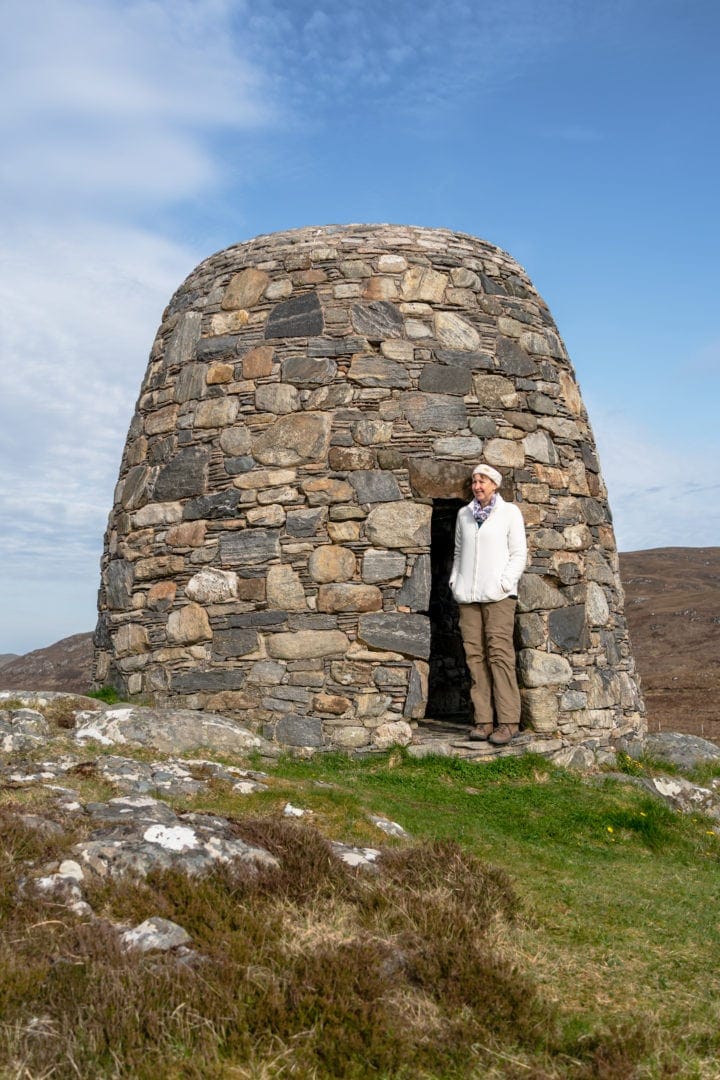
Day 2 Outer Hebrides Itinerary
- Callanish Stones
- Mangersta Sea Stacks
- Ardroli Beach
- Aird Uig
- Circular Scenic Route inc. Reef Beach, Cliff Beach
Callanish Stones
As an Outlander fan, I was keen to visit the ancient standing stones rumoured to be the inspiration behind Craig na Dun, where nurse Claire Randal is transported back to the Scottish Highlands of 1745.
The 5000-year-old Callanais Standing Stones (also called Callanish stones) rest on a hill on the Isle of Lewis. Formed in the shape of a Celtic cross, these stones are nothing short of breathtaking.
Photos alone can’t convey the mystical aura felt standing amongst these incredible stones.
Their significance, 5000 years ago, remains a mystery, but their spiritual attraction is almost tangible. At the base of the tallest centre stone, I notice a sprinkling of greyish, coarse dust and realise that I am looking at somebody’s recently scattered ashes.
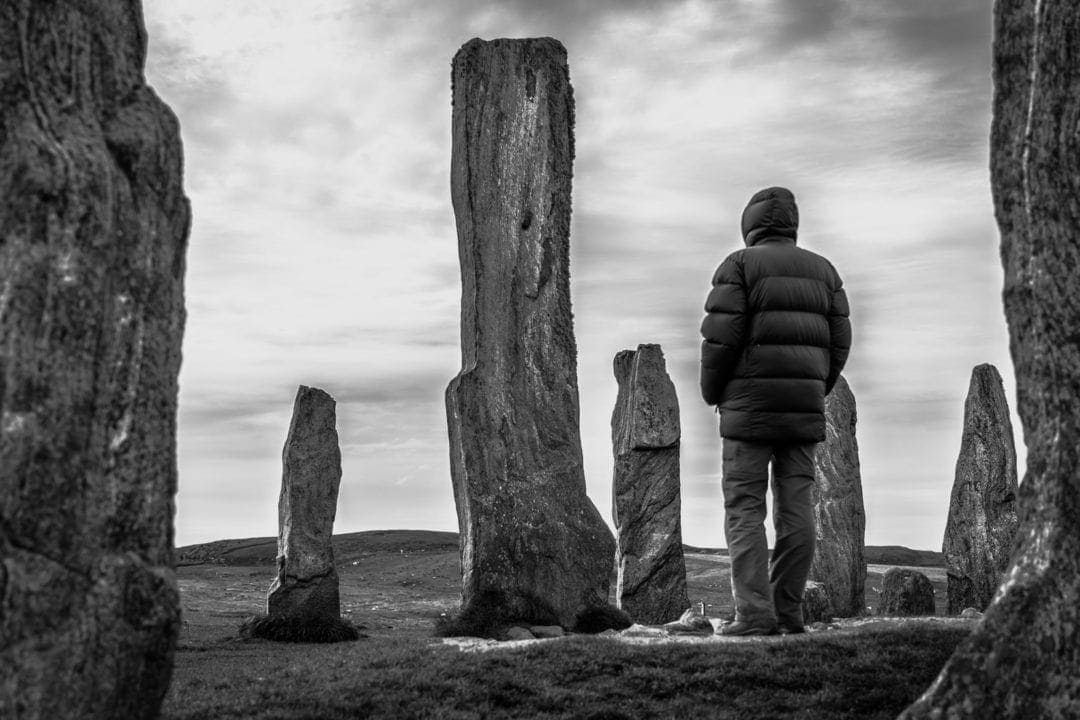
Archeologists are still baffled as to how these huge stones were manoeuvred to the site. What they do know about the Callanais stones, though, is that they are aligned with the Lunar Transit — a cycle of 18.6 years. Once each cycle, the moon shines directly onto the central stones.
If interested in learning more, you can listen to the Callanais Conversation series or watch this insightful documentary on the UK’s standing stones by the Prehistory Guys, (The Callanish Standing Stones are shown at the 2-hour mark).
Along with the largest Callanais Stones are other nearby smaller formations. Callanais II is a stone circle arranged in an ellipse shape, with five of the seven stones still standing.
Just a little further along the hill, overlooking Loch Ceann Hùlabhaig, is another set of well-preserved monolithic stones, Callanish III.
In fact, there are about ten sets of neolithic Callanais stones in the area.
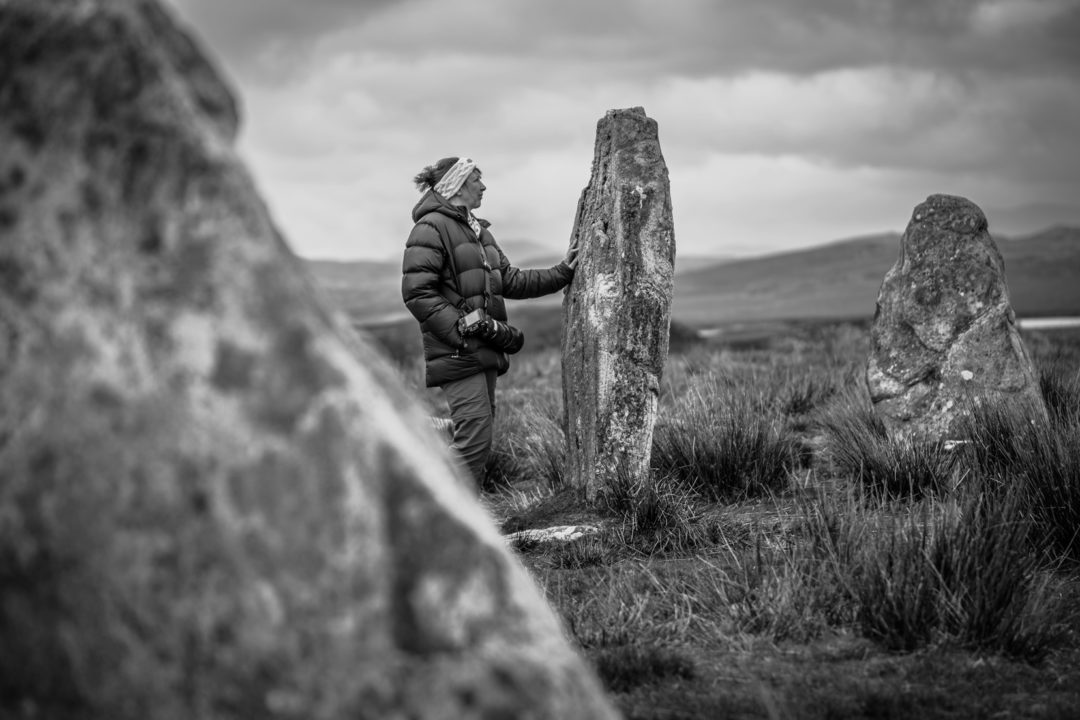
Mangersta (Mangurstadh) Sea Stacks
The Mangersta sea stacks are great subjects for photographers, just along from Mangurstadh Beach. If you’re feeling energetic, there is also a lovely circular cliff walk around the cliffs and onto the beach.
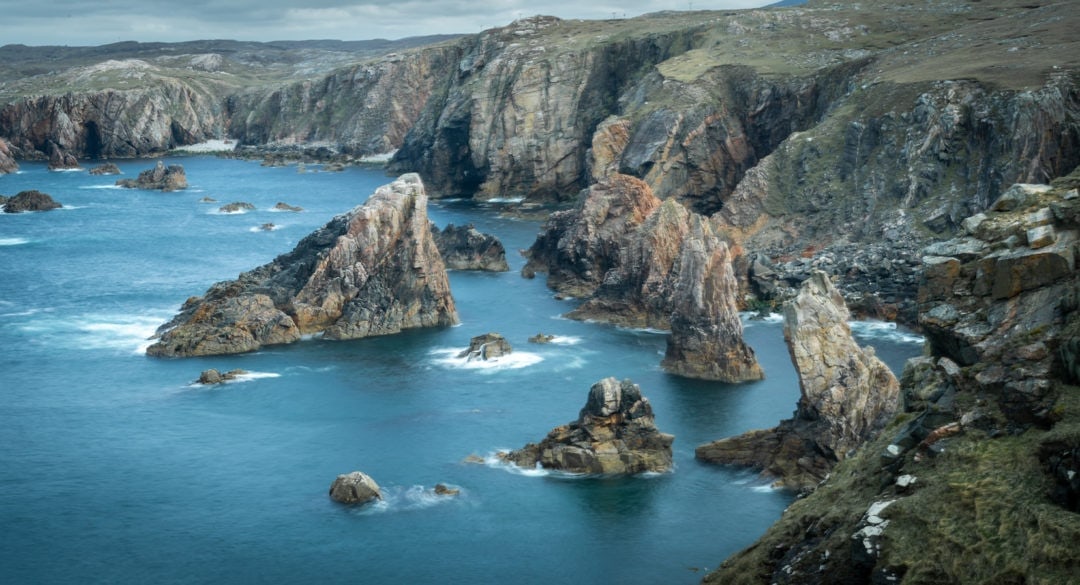
Ardroil Sands Beach
Ardroil Sands and Uig Bay are a little further north of the Mangersta Stacks. This photo doesn’t do the beach justice and would be best photographed when bathed in the morning or evening light.
Uig Bay, just around the corner, is where the 78 ancient Lewis Chessmen box was uncovered in 1831. Nearby is a large wooden carving of the King chess piece (see map).

The Circular Scenic Route
Turning off the B8011, this circular scenic route takes you through a large area of machair with the road skimming the cliffs and more gorgeous beaches, including the photogenic Reef Beach (Traigh na Beirghe).
Machair is a rare fertile grassy plain. In fact, it is one of the rarest habitats in Europe. In summer, it abounds with wildflowers.
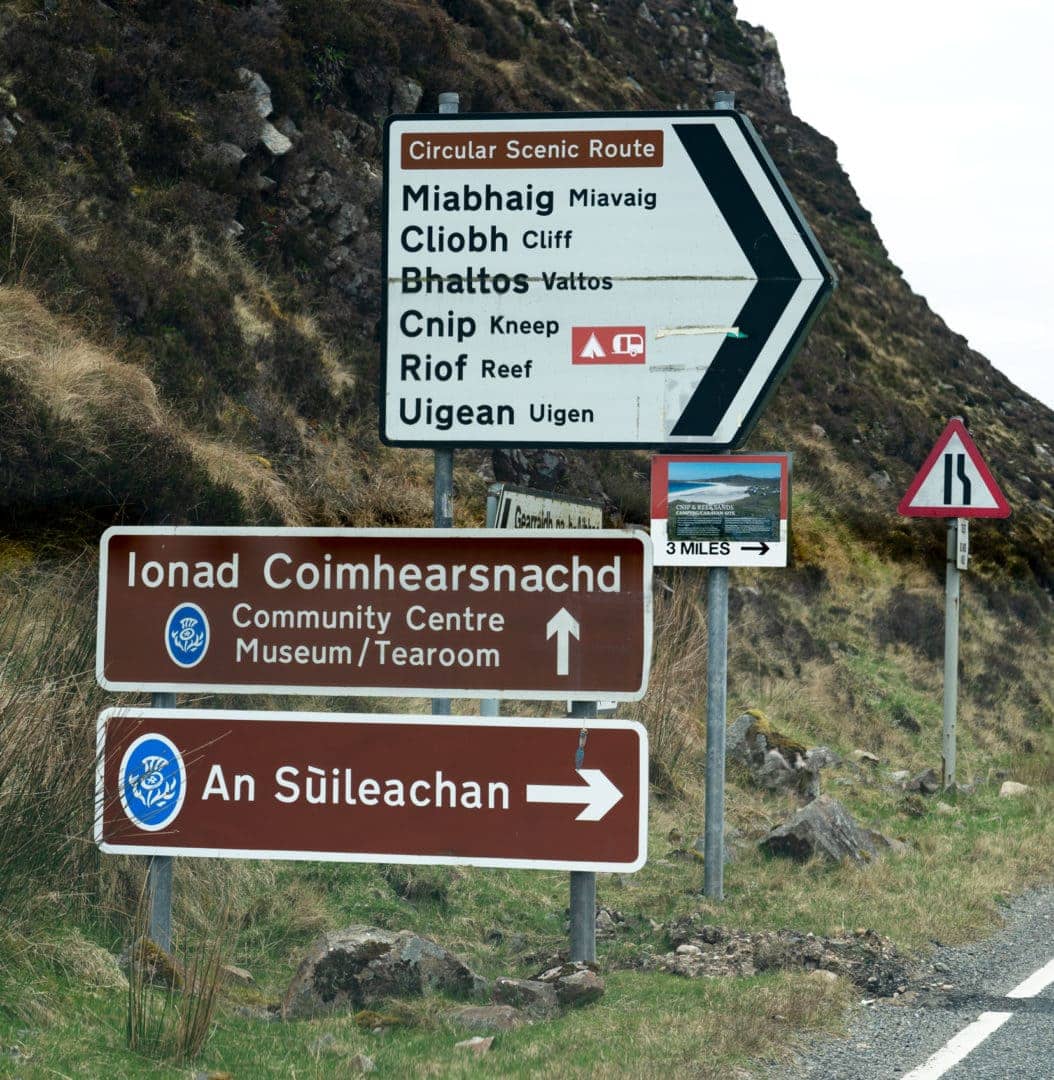

Day 3 Outer Hebrides Itinerary
- Weaving Shed
- Lews Castle and Museum
- Stornaway
- Lewis War Memorial
- St.Columba’s Church
- Garry Beach, (Traigh Mhor)
The Weaving Shed
Miriam Hamilton, the owner of The Weaving Shed, is an independent Harris Tweed Weaver who lives in the tiny village of Crossbost on the Isle of Lewis. She weaves her own unique designs on her 80-year-old Hattersley Loom, selling some of the cloth and using the rest to create her clothing, bags, home wear and accessories.
Miriam breeds her own sheep, spins their wool and then weaves it into her exquisite designs. Not only is Miriam’s tweed made into garments such as jackets, scarves, shawls and jewellery, but she also creates art from items she finds on the beach.
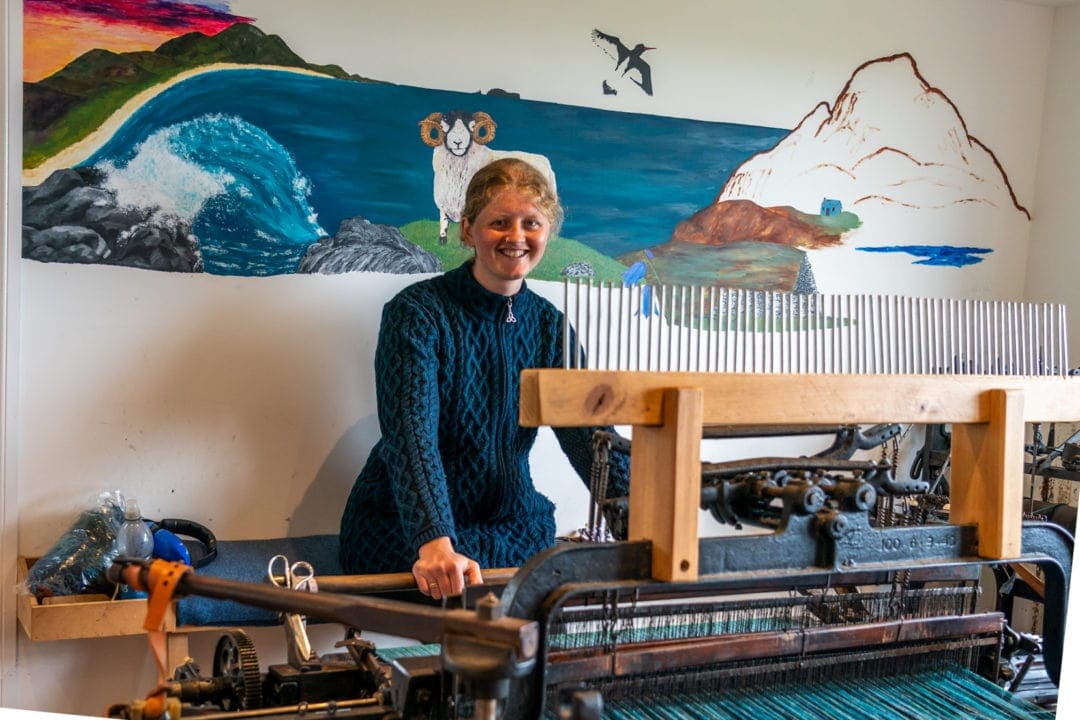
In her shop at The Weaving Shed, you’ll also find framed feathers decorated with tiny images of local wildlife and wonderful hand-painted watercolour prints. You can find all of her products online here.
The regular Harris tweed produced on the island is hand-weaved by locals, but the wool used mainly comes from the mainland. Therefore, not quite as authentic as that produced by Miriam at The Weaver’s Shed.

Miriam dreamed of producing her own tweed since she was 12 years old and used to come to the island for holidays from her hometown in England. Her dream came true when she moved to the island in 2017 and a local sold her his 1940 Hattersley loom.
The colours used in her creations reflect the island’s colours, the ocean’s blues and greens, the gold of the sandy beaches, and the purple of the moor heather.
If you visit The Weaving Shed for a small fee (refunded with a purchase from the shop), you can watch Miriam weave her magic on the 80-year-old loom.
Absorb the repetitive clunking of the loom as you read about the history of the weaving business that has been carried out in the Outer Hebrides for hundreds of years.
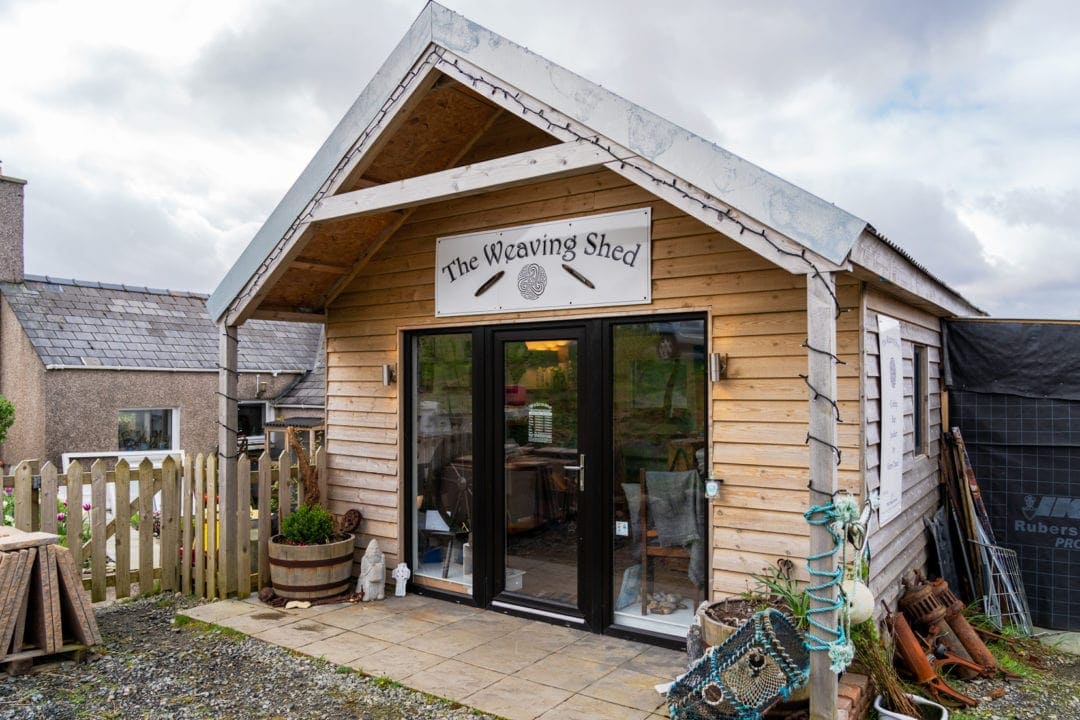
Harris Tweed
Harris Tweed (or Clo Mor), has been produced on the island for hundreds of years. However, it wasn’t until the mid-19th century, when Lady Dunmore showcased the fabric to the aristocracy in 1846, that it became so popular. The Harris Tweed Act of 1993 protected the island’s cottage industry by enforcing certain requirements for the production of Harris Tweed.
One of those was that the tweed must be hand-woven on the island. The Harris Tweed trademark is one of the oldest British trademarks in continuous use since 1911.
Lews Castle and Museum
A great place to explore the outer Hebrides’ history and culture is at the Museum nan Eilean, at Lews Castle in Stornaway. Multimedia, video and traditional cabinet displays convey the essence of the island and its rich history.
Six of the famous Lewis Chessmen, intricately carved out of walrus tusks and whale teeth in the 12th century, are on display in the museum and were made even more popular after being used as inspiration for the chess pieces in the movie Harry Potter and the Philosopher’s Stone.
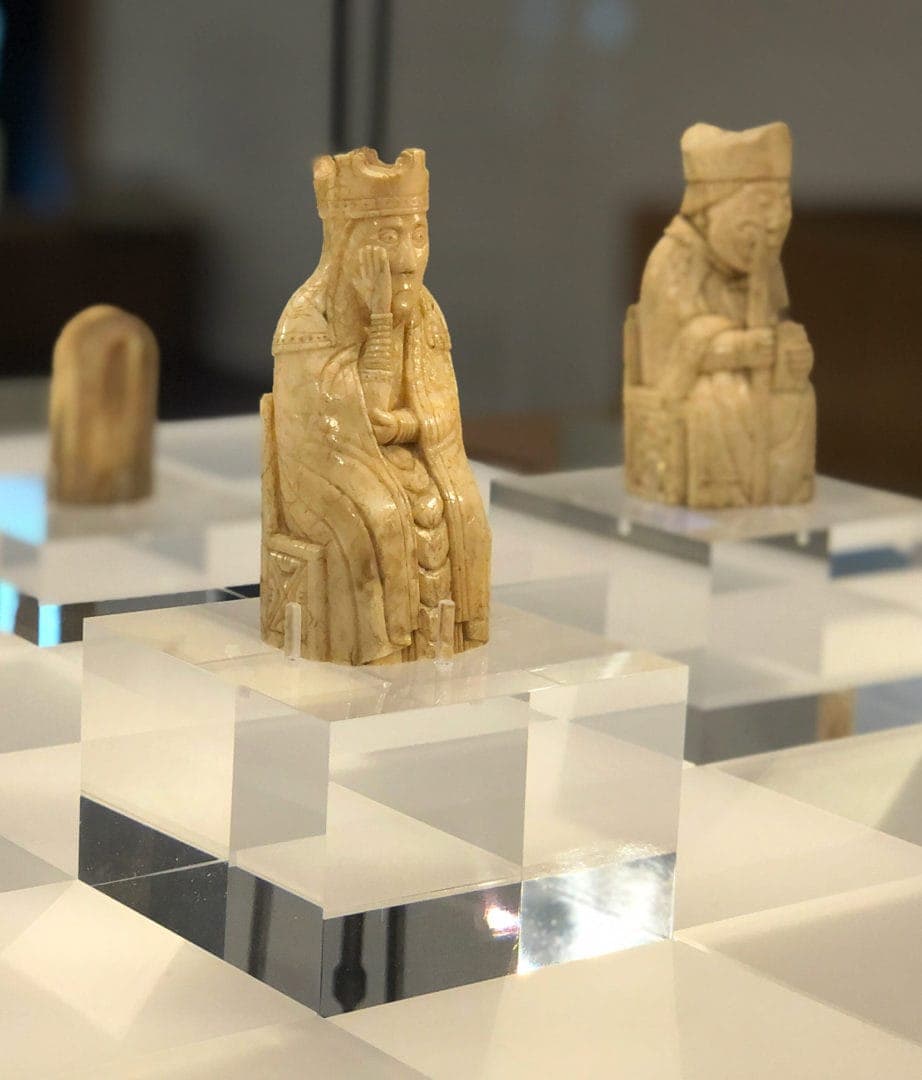
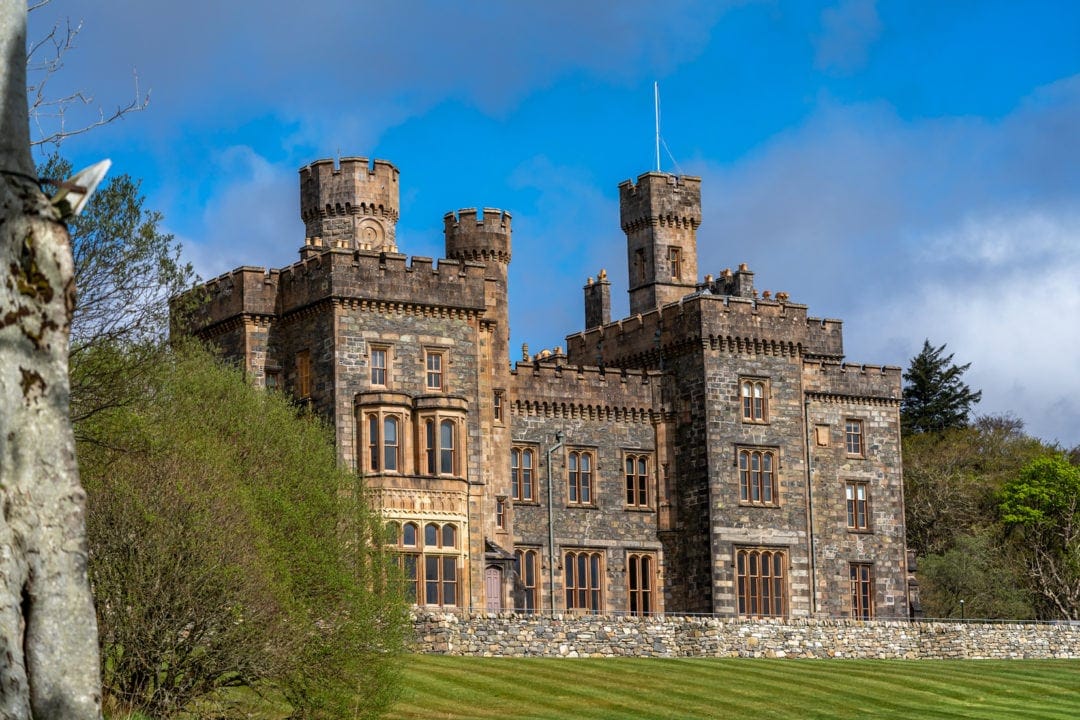
The Castle Grounds, overlooking Stornoway Harbour, are gorgeous to wander, with both woodland and coastal walks.
You can even book a stay at Lews Castle in one of their many rooms.
Stornoway
Stornoway is the largest town in the Outer Hebrides, and as well as visiting Lews Castle and the museum, we would recommend a wander around the town following the sculpture trail.
You can pick up a handout at the tourist information centre in the centre of town and have also marked up as many as we can remember on the map above.
They are a combination of memorials, statues, sculptures, and murals depicting local life and culture.
One of the most poignant is the Iolaire Monument — poles in the shape of a boat in the harbour. This is in memory of the sinking tragedy that befell the ship in 1919, just before it came into the harbour, losing 205 men.
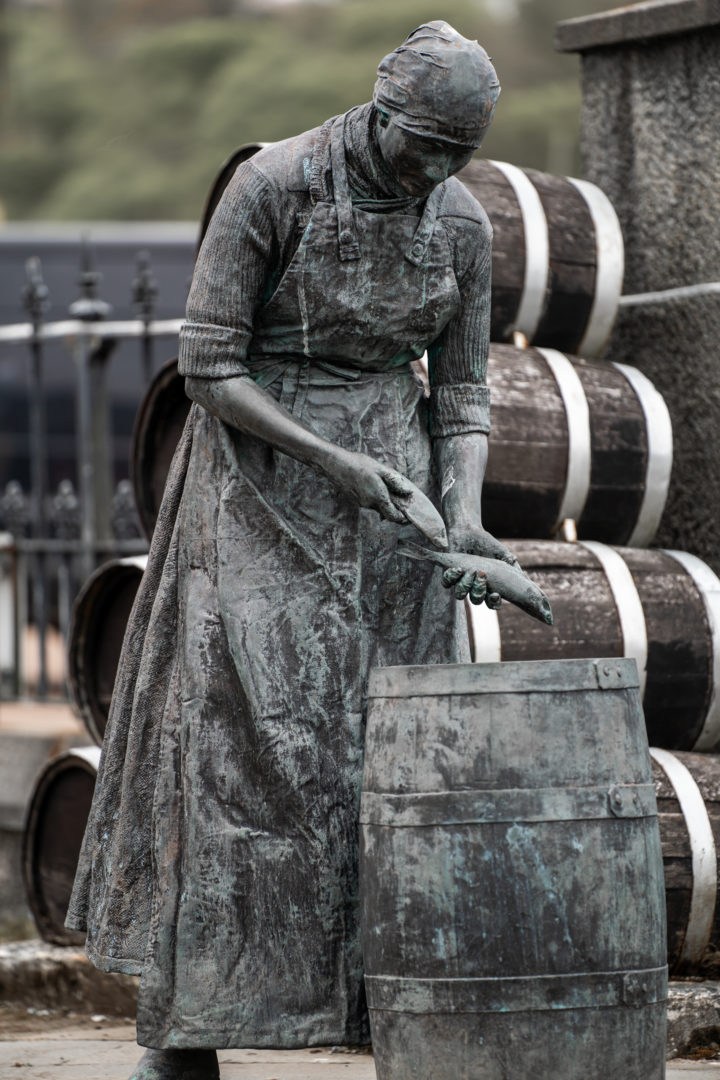
Lewis War Memorial
The Lewis War Memorial is on the outskirts of the town centre, on the highest point of Stornoway. The poppy red door is apt, and the base of the tower has seating recesses on each side with impressive views across Stornoway and to the coast.
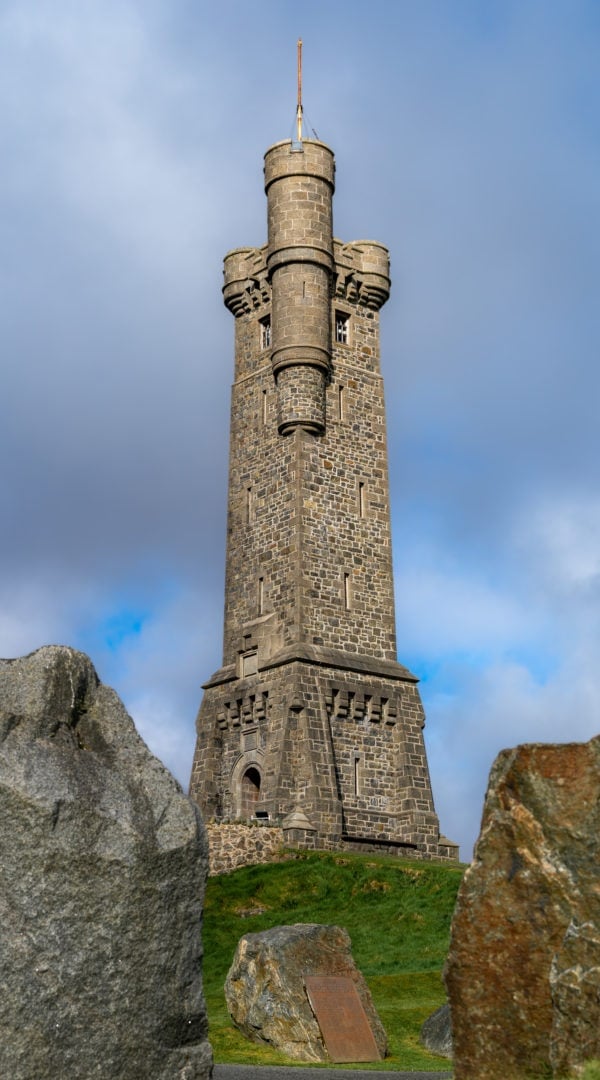
St Columba’s Church
During the medieval period, St Columba’s Church (or Eaglais na h-Aoidhe ) was the main church of the island and the burial place for the MacLeod and Mackenzie chiefs.
Today, it is one of the few and most complete remains of the medieval and post-medieval period on Lewis, with part of a wall dating back to the 13th century.
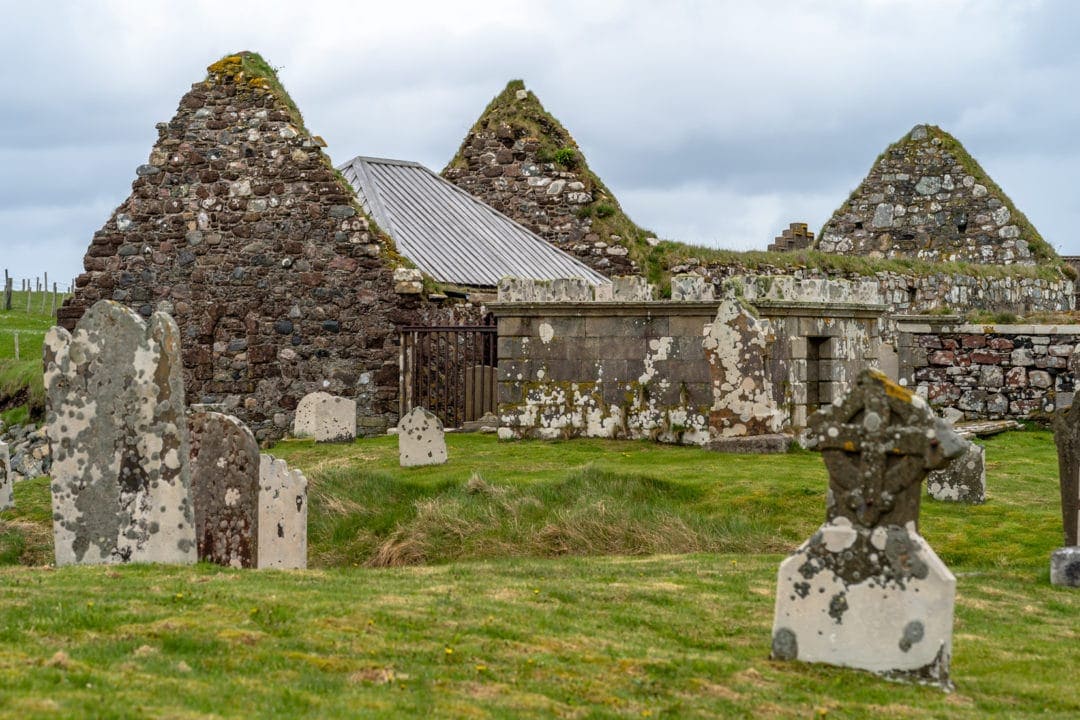
Garry Beach, (Traigh Mhor)
Garry Beach is yet another stunning location, but this one is on the east coast of northern Lewis. It is known for its Bridge to Nowhere, built in 1920 as part of a road from Tolsta to Ness, which was never completed.
The beach also boasts impressive sea stacks at the southern end of the beach, making it a great subject for avid photographers.
If you’re captivated by the Outer Hebrides and its coastal charm, you might also enjoy Ireland’s enchanting landscapes. Explore our detailed itinerary through Ireland, which highlights why it is worth visiting.
While Lars clicked away on the beach, I walked along the rising coastal path, chatting with the local grazing sheep.
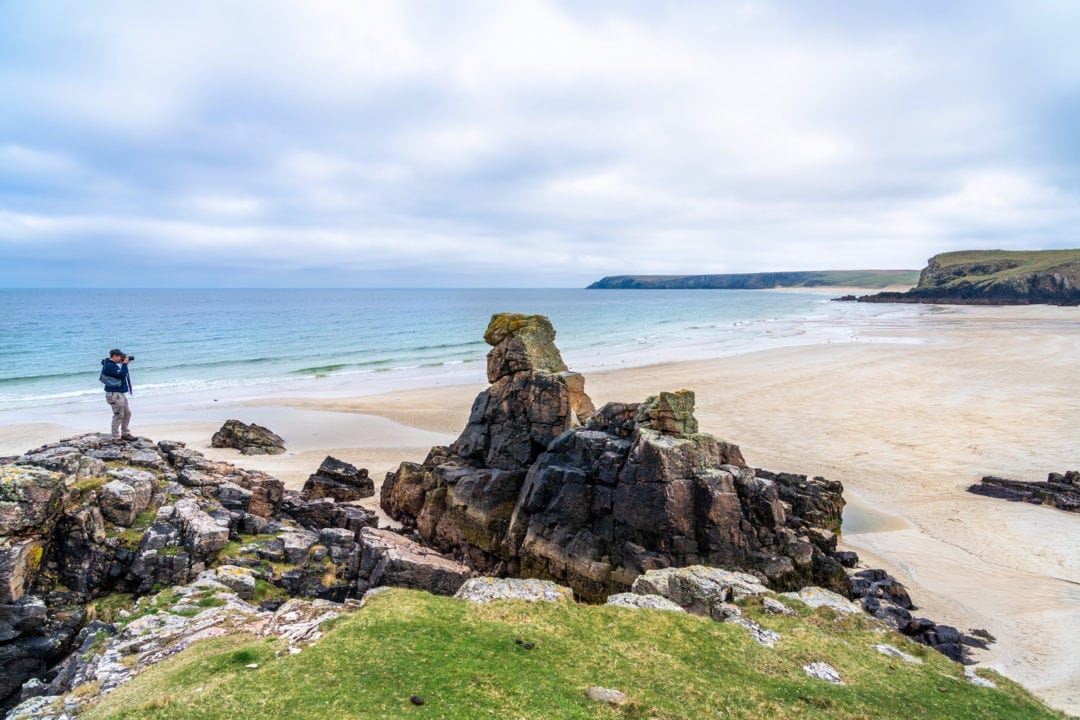
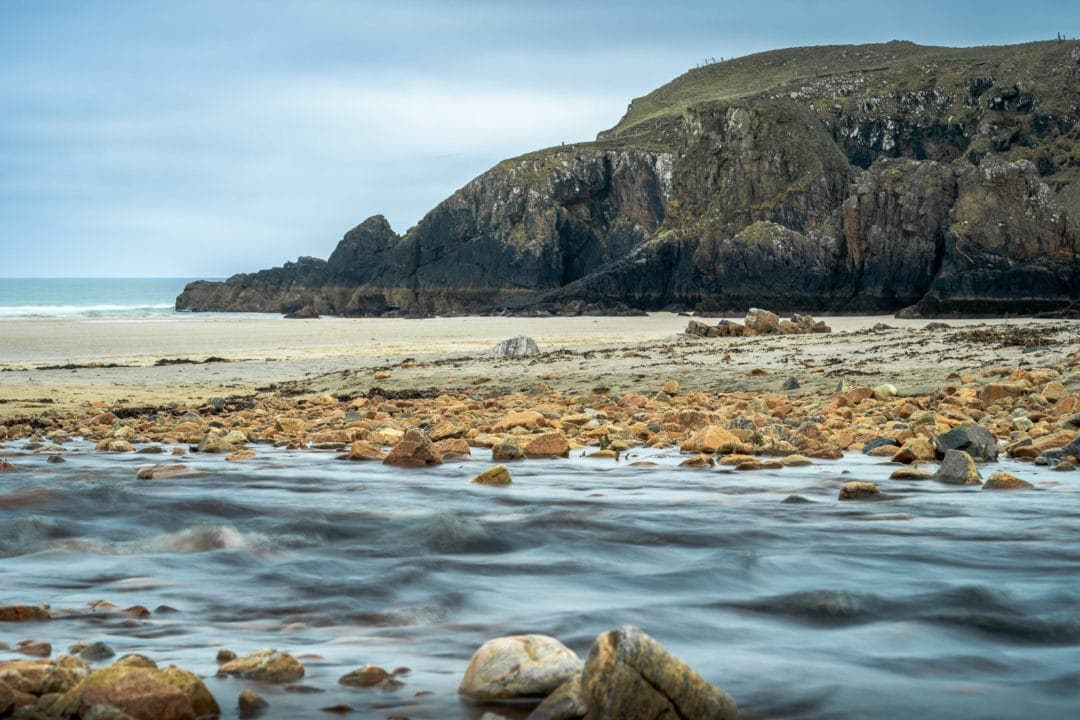
Day 4 Outer Hebrides Itinerary
- Dun Carloway Broch
- Gearrannan Blackhouse Village
- Arnol Blackhouse
- Whale Bone Arch
- Dalmore
- Butt of Lewis
- Hebridean Sheep
- Steinacleit Cairn and Stone Circle
- Clach an Truseil Standing Stone
Dun Carloway Broch
Dun Carloway Broch (Dùn Chàrlabhaigh), is an example of Iron Age architecture and was likely built around 200 BC. Although it was closed for conservation work, we could still get close enough to see the outside of it.
A ‘Broch’ is an Iron Age drystone hollow-walled structure only found in Scotland. The Carloway Broch is open all year, but the Visitor Centre — on the opposite side of the road, is only open from April to September.
The Carloway Broch is thought to have been constructed in about 200 BC. Broch-building ceased around AD 100, but evidence suggests this broch may have been used until about AD 1000.
Later, the Morrison clan used the broch, in the 1500s, as a hiding place when they stole cattle from clan MacAulay. But were burnt to death when the McAuleys discovered them and pushed burning heather in on top of them.
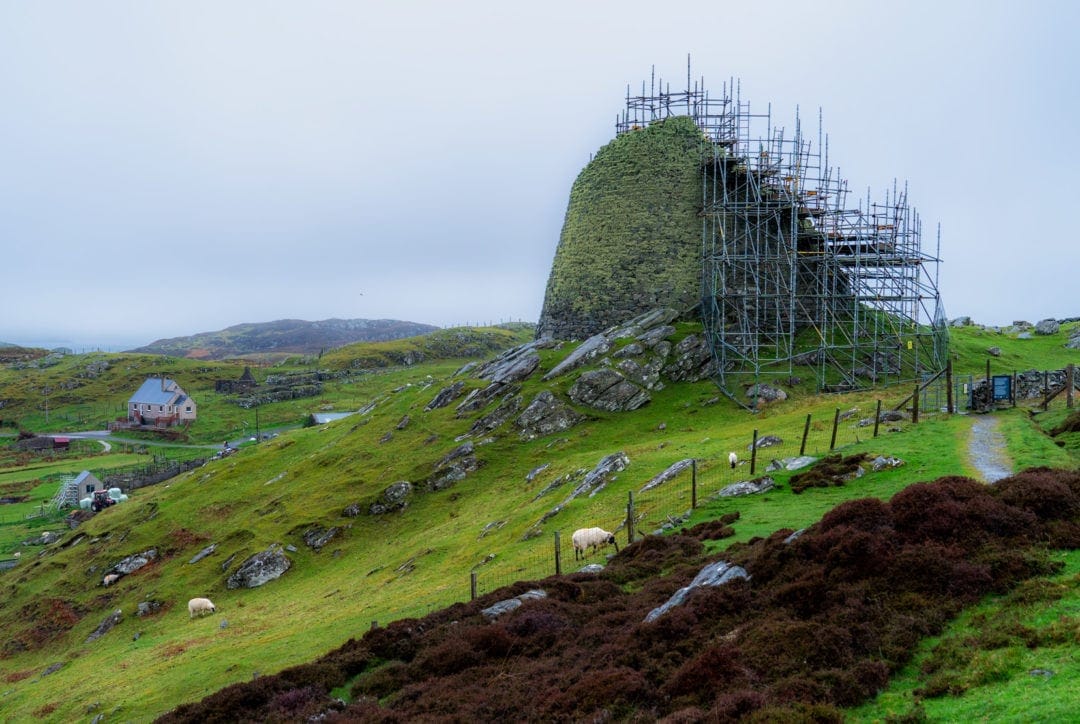
Gearrannan Blackhouse Village
Gearrannan Village is a restored village of nine buildings and a croft (small working farm). One of the buildings is a blackhouse museum, and another is an interpretation room showing videos about weaving and the island peat collection.
The videos are interesting, especially the one that highlights how the islanders collect and use peat.
The Importance of Peat on the Island
On your Hebridean road trip, you’ll notice a distinct lack of trees; without wood for fuel, the islanders rely on peat.
Locals are allocated a section of the moor where they can harvest their peat. The process involves cutting the peat and a series of turning and drying before stacking for home use. As you cross the moors, you can see trenches where the peat has been dug out,
The Blackhouse at Arnol lets you experience the full-bodied aroma of a peat fire and an idea of how this method of heating was used in the past.
Four of the buildings are traditional thatched croft cottages providing self-catering accommodation.
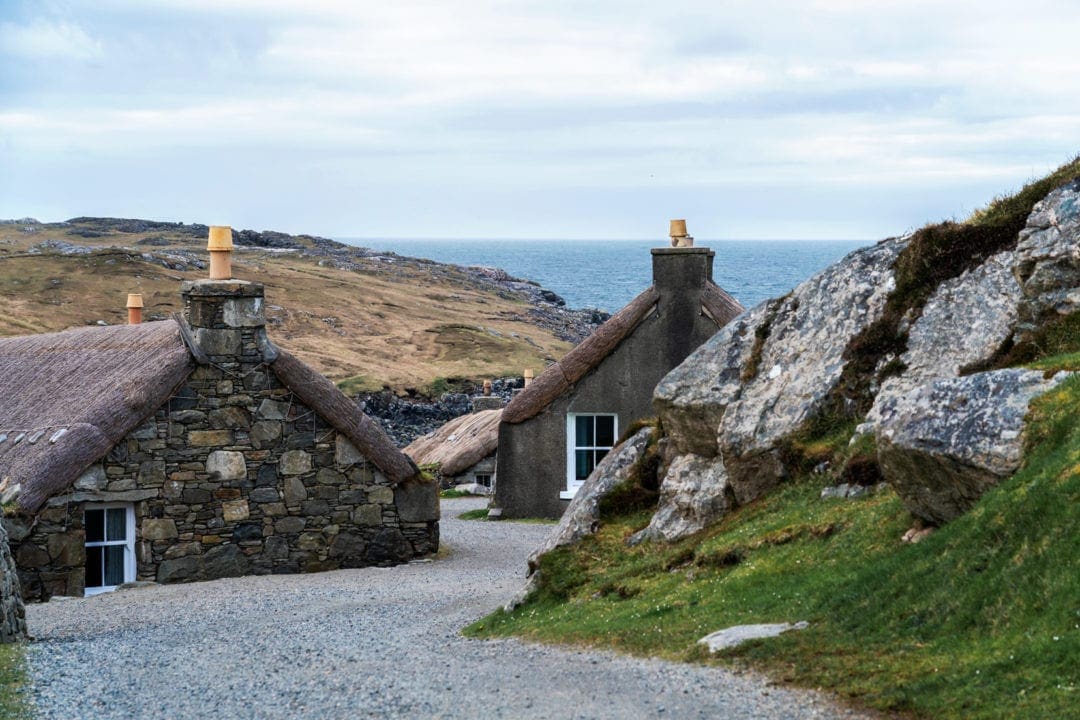
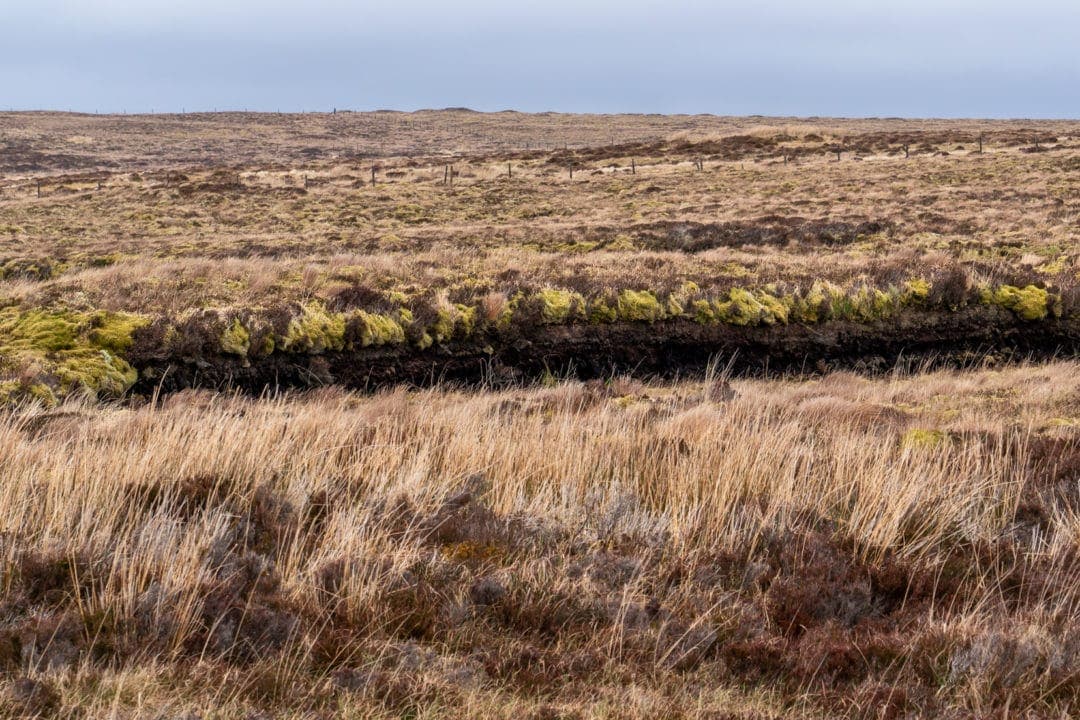
The Blackhouse, Arnol
Stepping into the Blackhouse, it’s immediately clear why it’s called a Blackhouse. The peat smoke from the centre fire, which is never allowed to go out, coats everything in sight.
The all-encompassing smell of peat smoke, repulsive to some, seems comforting to me — perhaps it’s due to my Scottish heritage, my DNA wired to associate the smell with homely warmth.
Investigating my family tree, I discovered that I am descended from King James IV of Scotland … but that’s another story.
Animals lived alongside the inhabitants in a blackhouse with no chimney or windows. Across the road from the Blackhouse is an example of a ‘White house’, the sequel to the Blackhouses.
Blackhouses were mainly abandoned in the 1920s when health regulations made it necessary for animals to be kept separate. At that time, the new ‘white’ houses had windows and chimneys.
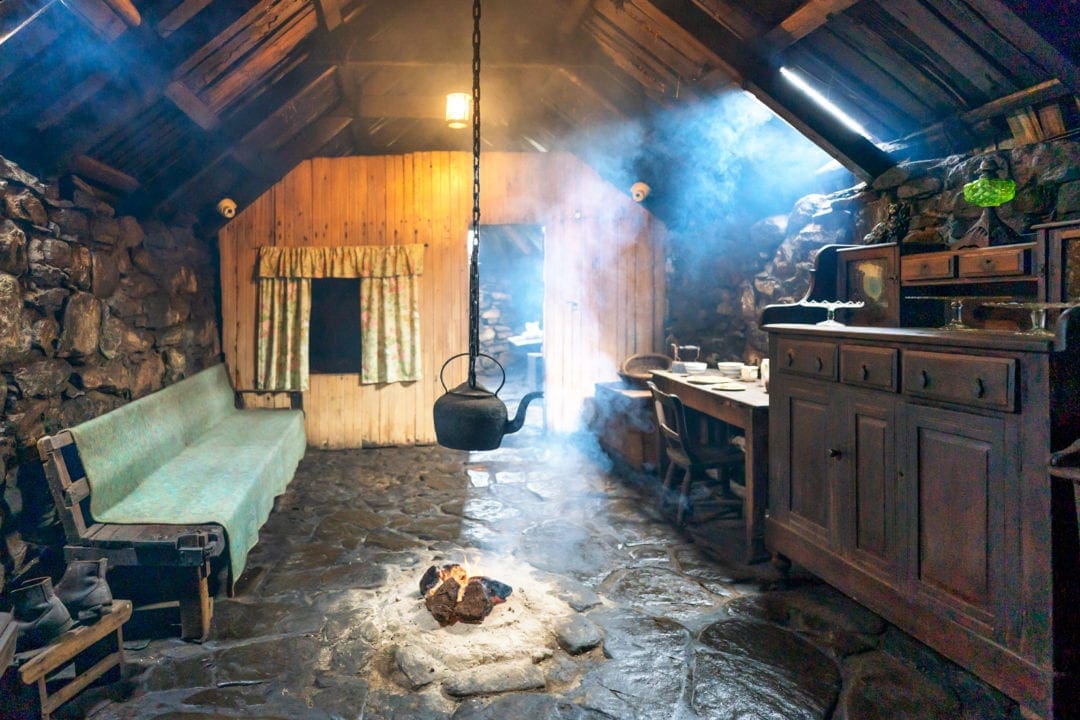
Whale Bone Arch
The Whale Bone Arch is beside two houses on the A857 at Bragar. The bones are the lower jaw bones of an 80-foot-long blue whale that beached in Bragar Bay in 1920. It had a harpoon in its head that hadn’t detonated, so it suffered a slow death.
The corpse began to rot, and the stench was too much for the villagers of Bragar, who decided to deal with it themselves when no help arrived to deal with the decaying whale. The blubber was used for oil, disinfectant, ointment, tar, and medicine.
The local postmaster, Murdo Morrison, had the idea that the jawbone would make a nice addition to his gate, and so that is why you can see this 25ft high, 4-tonne whale jaw with the harpoon as an ornamental arch in Bragar.
To take a photo, you need to enter the driveway gate just off the road. This is somebody’s home, so please be respectful. We read that the owners don’t mind you entering to take a photo.
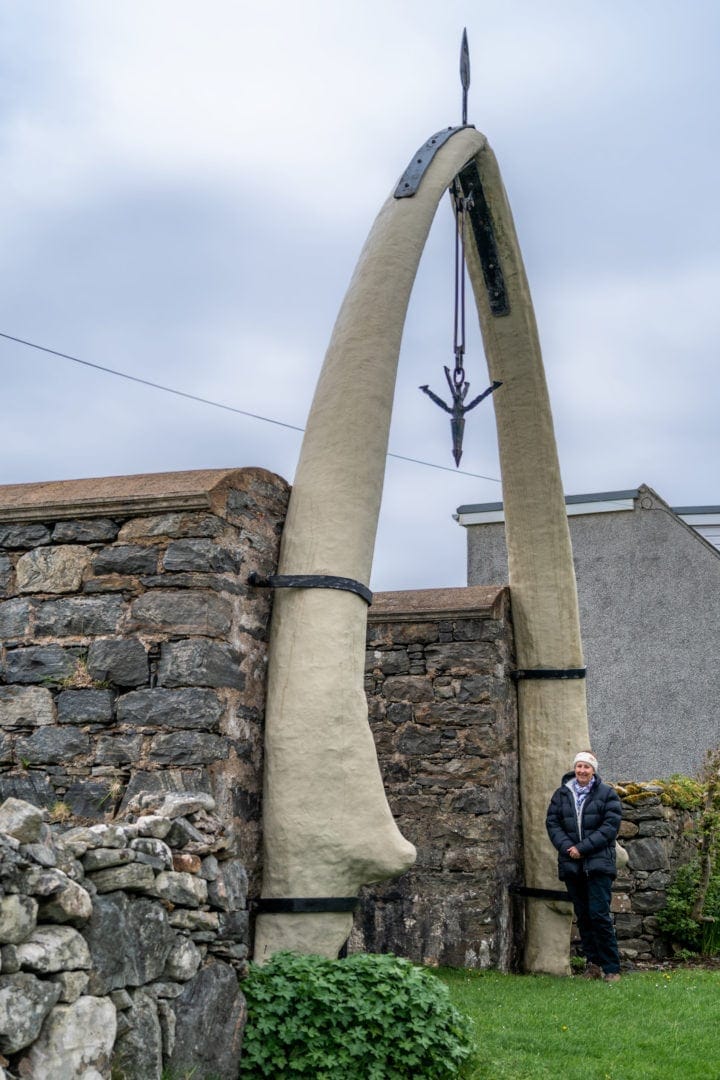
Dalmore Beach and Stacks
Dalmore or Dail Mhor Beach is found at the end of a narrow lane and beside a graveyard, both bearing the brunt of the Atlantic weather pounding the shores.
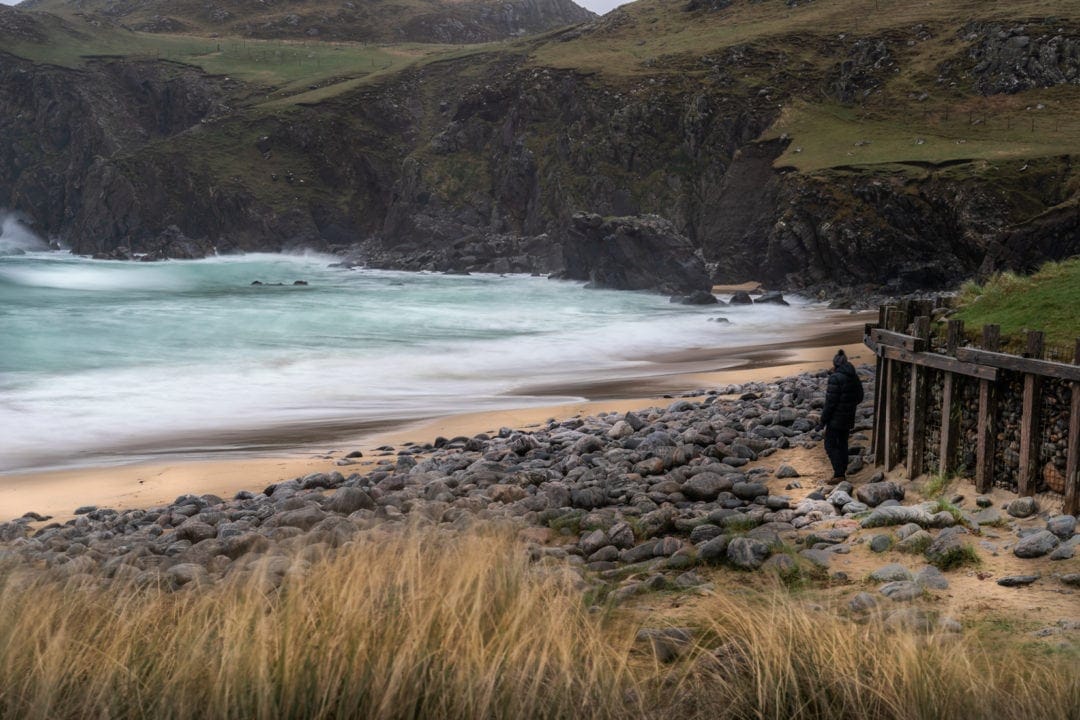
Clach An Truishal Standing Stone
Clach an Truseil, or Trussel Stone (and various other spellings), is one of Scotland’s tallest neolithic stones. Standing tall at about 19 feet and a lone sentinel amongst crofts and moorland, it seems forgotten but makes a handy perch for local birdlife.
Once part of a stone circle, its past use has long since been forgotten, with many of its stone counterparts used as door lintels and building materials. Though now protected by Historic Scotland, the Trussel Stone tends to fly under the radar of many visitors.
Like us, if you visit, you may very well have this 5000-year-old piece of history to yourself.
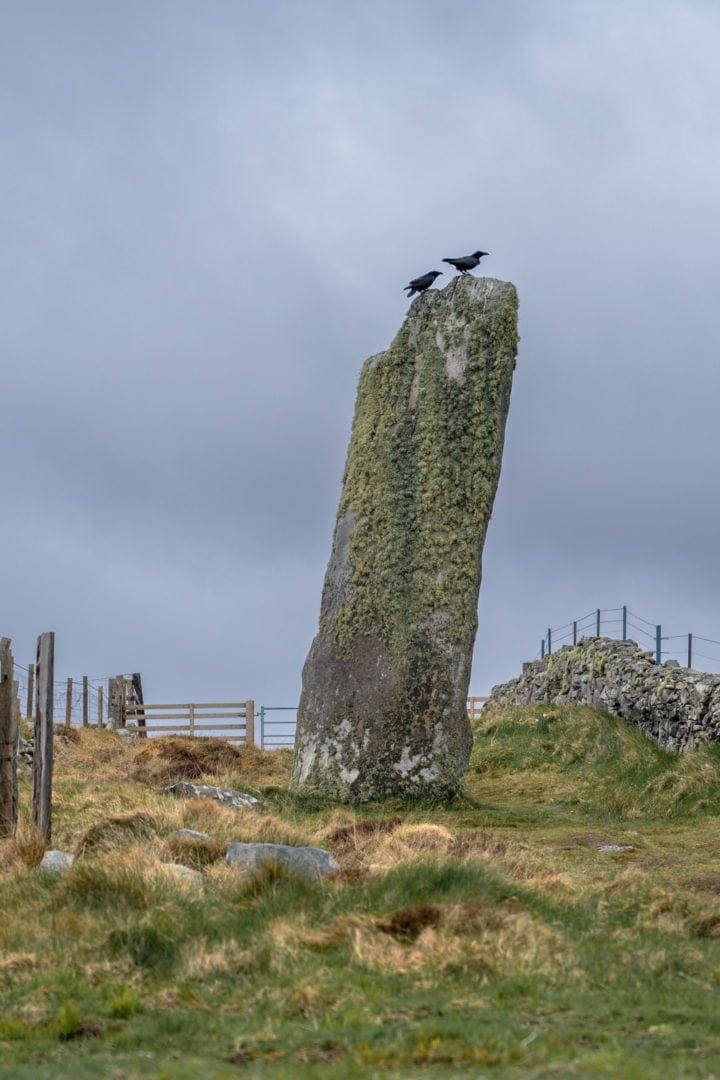
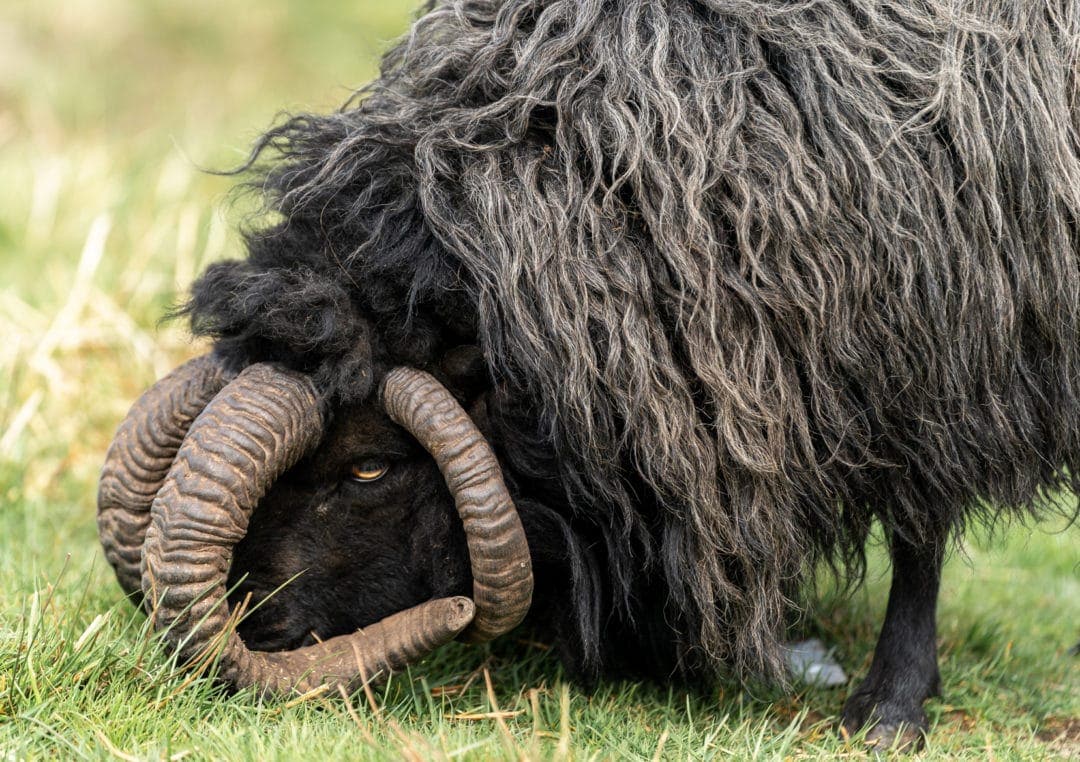
In the field to the left, as you turn into the lane to visit the Trussel Stone, you may be lucky enough to see a group of Hebridean sheep.
Steinacleit Cairn and Stone Circle
Steinacleit was discovered in the 1920s under layers of peat. It was at first thought to be the remains of a large chambered cairn and stone circle, but archeologists now think that rather than 5000 years old, it is perhaps 3000 years old and was a prehistoric farmstead.
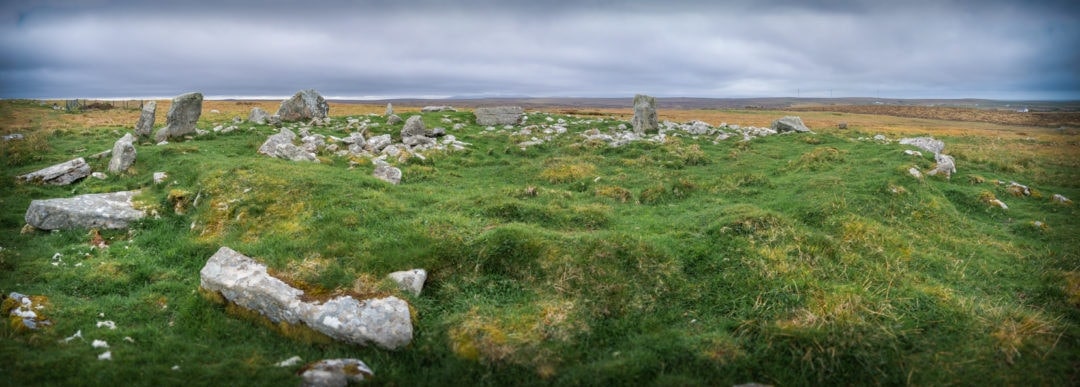
Butt of Lewis
The Butt of Lewis, the most northerly point of the Outer Hebrides, is said to be the windiest point in the UK, and it certainly lived up to its name when we stopped there on our tour of the Hebrides.
We’d had a tip that orcas had recently been swimming near the coast, but unfortunately, they’d moved on by the time we arrived. We did, however, spot many seabirds, such as guillemots, shags and lots of oystercatchers on the cliffs.
David and Thomas Stevenson built the 121 ft Butt of Lewis Lighthouse between 1859 and 1862. The road network here was so bad that the building materials needed to be landed in Port Stoth, a small bay a few hundred metres south on the east coast. You can still see the ramp used to hoist the materials up today.
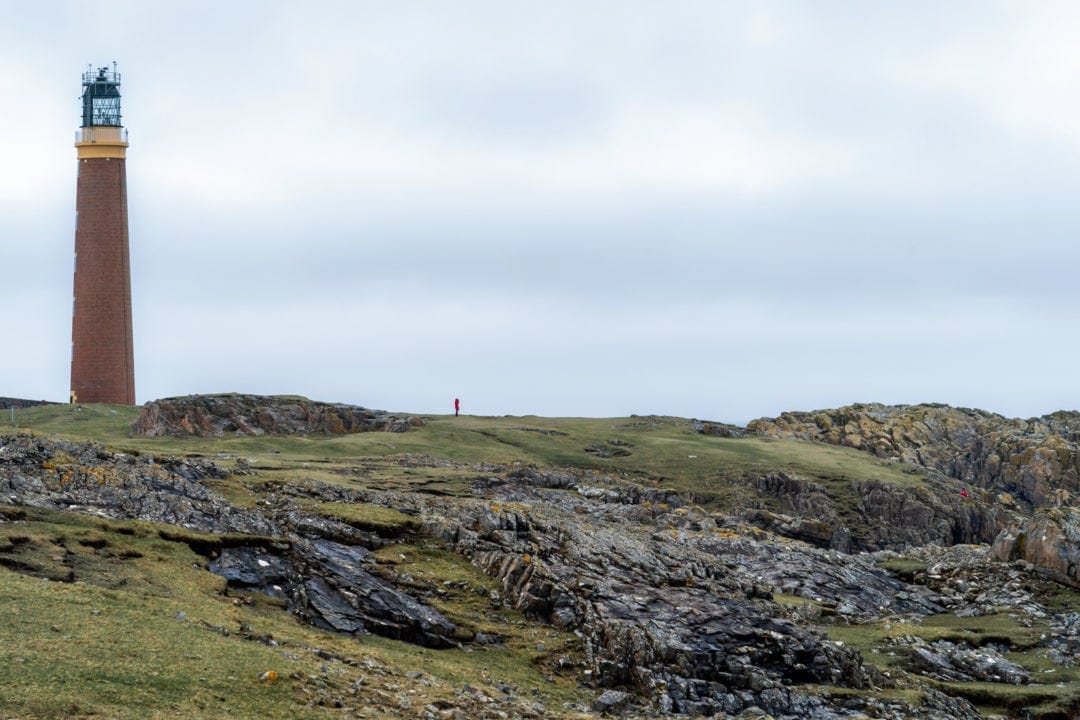
Driving in The Outer Hebrides
Many of the Outer Hebrides roads are narrow, single lanes, but there are plenty of passing places for you to pull in to let others pass.
Following these guidelines will help you travel more safely around the Outer Hebrides.
- Drive on the left
- If you are driving slower than the traffic behind you, pull into a passing place to allow traffic to overtake you
- Pull into the passing place on your left to let oncoming traffic pass
- DO NOT pull into a passing place on your right. Stay on your left and wait opposite a passing place to allow traffic to pass
- Don’t park in a passing place
- Look out for cyclists. In the UK, you need to give cyclists at least 1.5 metres of passing distance
- Keep a lookout for sheep (you will often find them on the road) and wild animals, such as deer
- It is illegal to use your mobile phone when driving
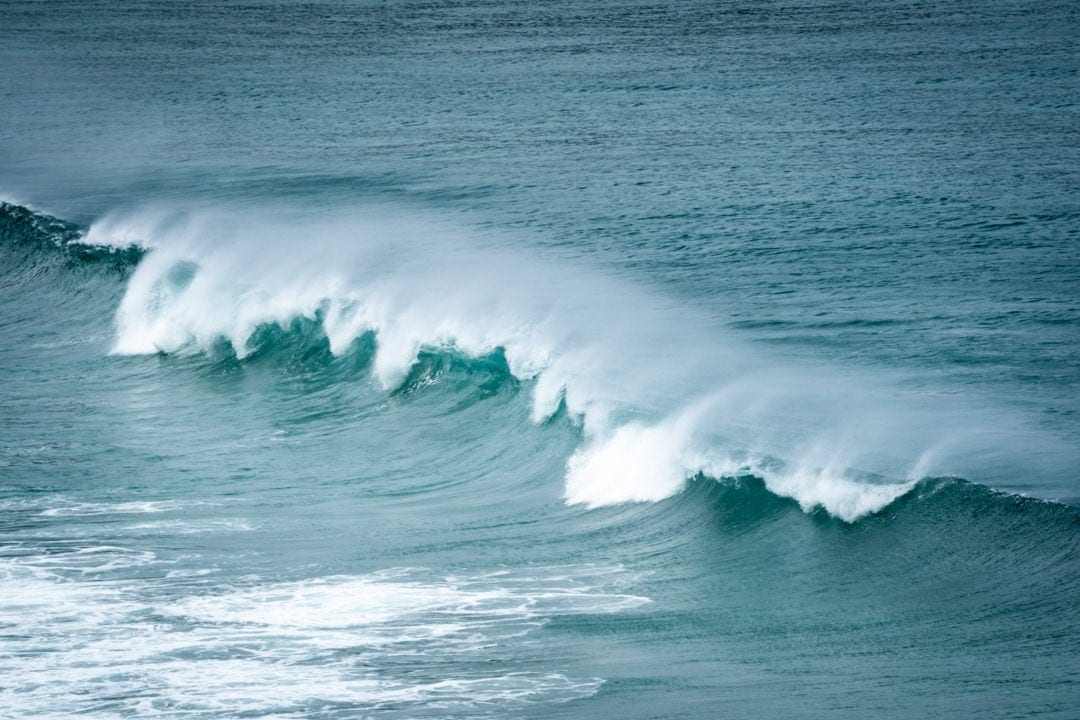
Visiting the Outer Hebrides: Good to Know
Sheep on the Outer Hebrides
On our Outer Hebrides road trip, it seemed that we couldn’t drive for more than a few hundred metres without seeing sheep. Every man and his dog seemed to have them. Visiting in spring made this even more noticeable as the lambing season was in full swing.
To distinguish the multitude of owners, the islanders need to use more than the usual red and blue markings on their sheep’s fleece.
On the Outer Hebrides, you’ll find pinks, yellows, greens, purples and every other hue of the rainbow. It makes for a colourful spectacle.
We asked several locals why there were so many sheep islands, and their answers surprised us.

Contrary to what many visitors may think, the islanders do not raise sheep in order to sell their wool for weaving into the Outer Hebrides’ famed Harris Tweed.
In fact, the price that crofters would receive for the fleece is less than the cost of shearing the sheep. Additionally, the amount paid for lamb meat is less than it would cost to feed the lamb.
Because the grass in the Outer Hebrides isn’t the best, lambs raised on the island are too small to cull until they are 18 months old. Therefore, only female lambs are kept so that they can produce other lambs to be sold.
The crofter’s profit margins are either non-existent or marginal, so many rely on grants from the Crofting Agricultural Grant Scheme (CAGS). This is the only way many of those living on the island can continue this type of farming.
Without the grants designed to ensure “crofting remains at the heart of rural and remote communities“, many would be unable to survive in the Outer Hebrides financially.
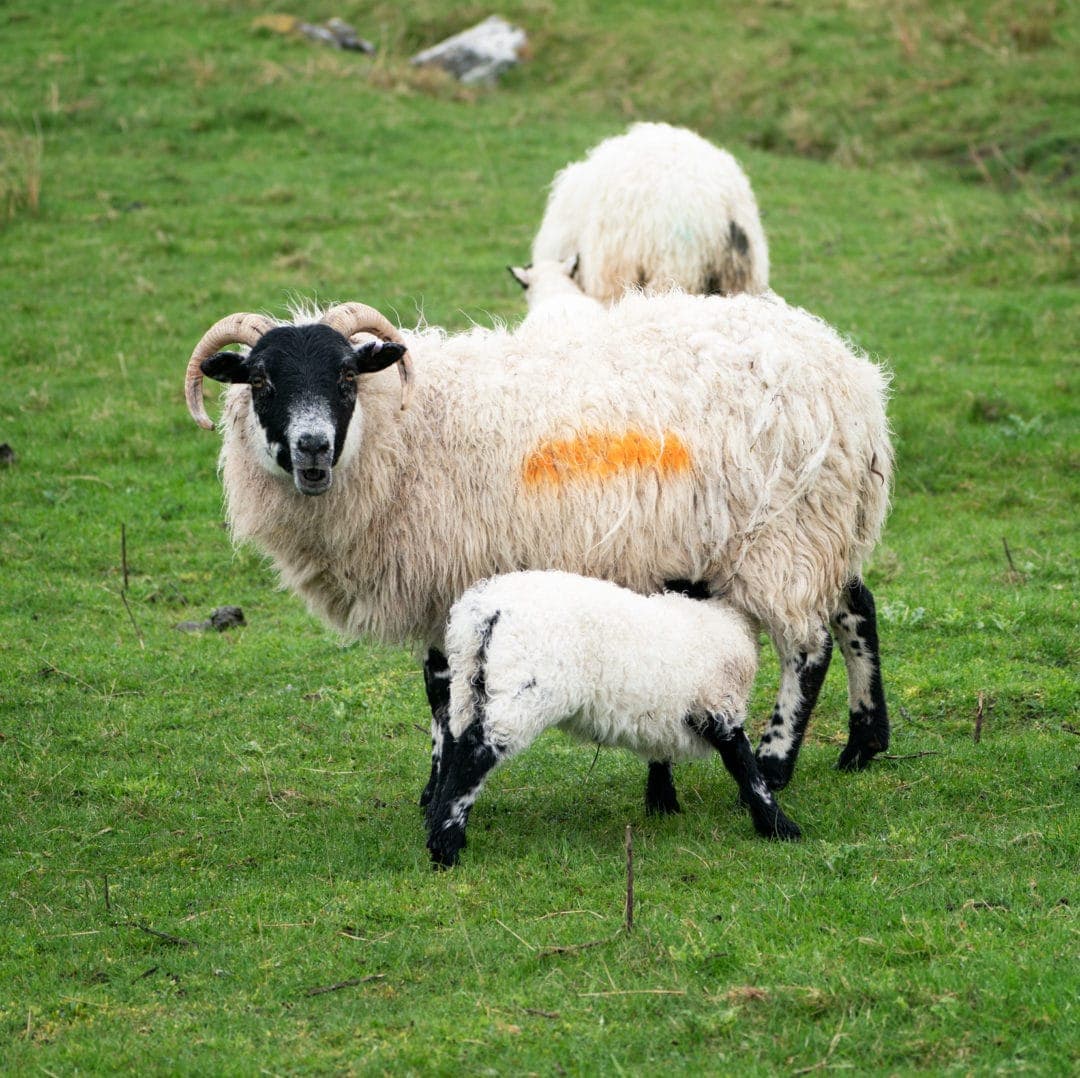
Wildlife in the Outer Hebrides
The island’s coastline, moor and over 4,000 lochs create a multitude of environments for wildlife to flourish.
I read that the Outer Hebrides is one of the best places to see otters, with more otters per square mile than anywhere else in northwest Europe. However, we weren’t lucky enough to spot any.
Seals, on the other hand, are plentiful, as seen at the large colony at Finsbay.
You can find a special type of sheep on the island known as the Hebridean Sheep. The multi-horned ones are very unusual, with some horns curling around the face and others pointing straight up.
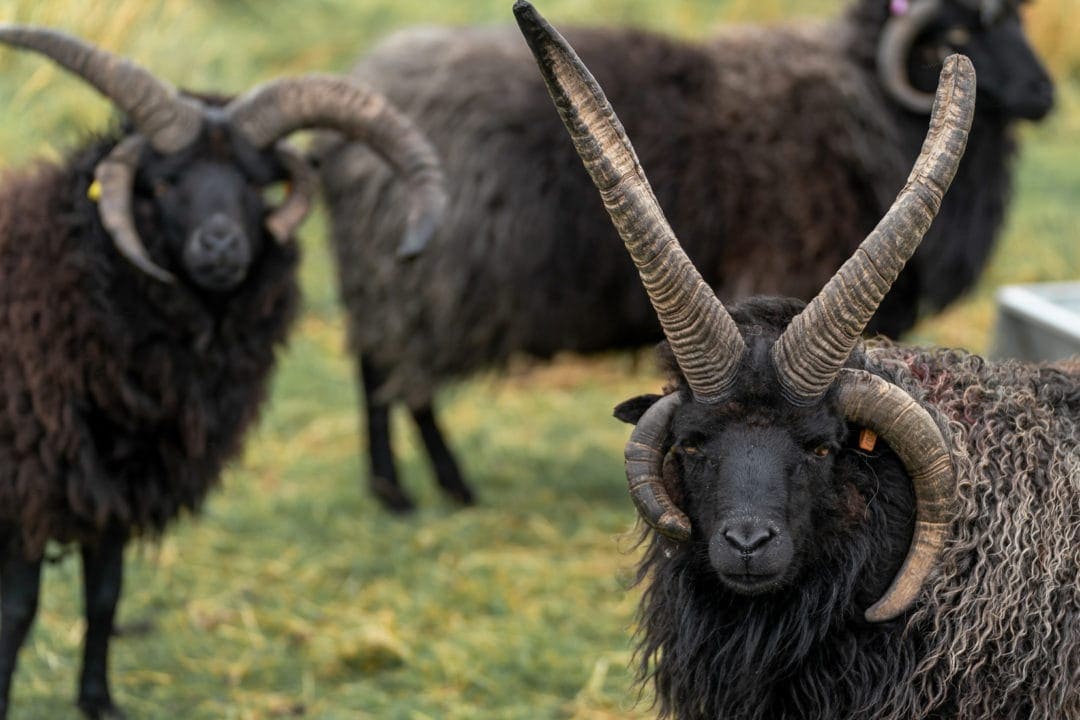
North Harris has the densest population of golden eagles in Europe. If you are a bird lover, you may want to add the North Harris Eagle Observatory to your list of places to visit. White-tailed eagles and other birds of prey can be found throughout the island.
We saw several deer as we crossed the moor along with a multitude of fulmar, shags, oystercatchers, grey heron, herring gull, seals, and, let’s not forget, sheep on our Outer Hebrides road trip.
Tips from the locals when we were in the Outer Hebrides in May:
- The Butt of Lewis — Orcas, seals and dolphins
- Tiumpan Head Lighthouse — whales, seals and dolphins
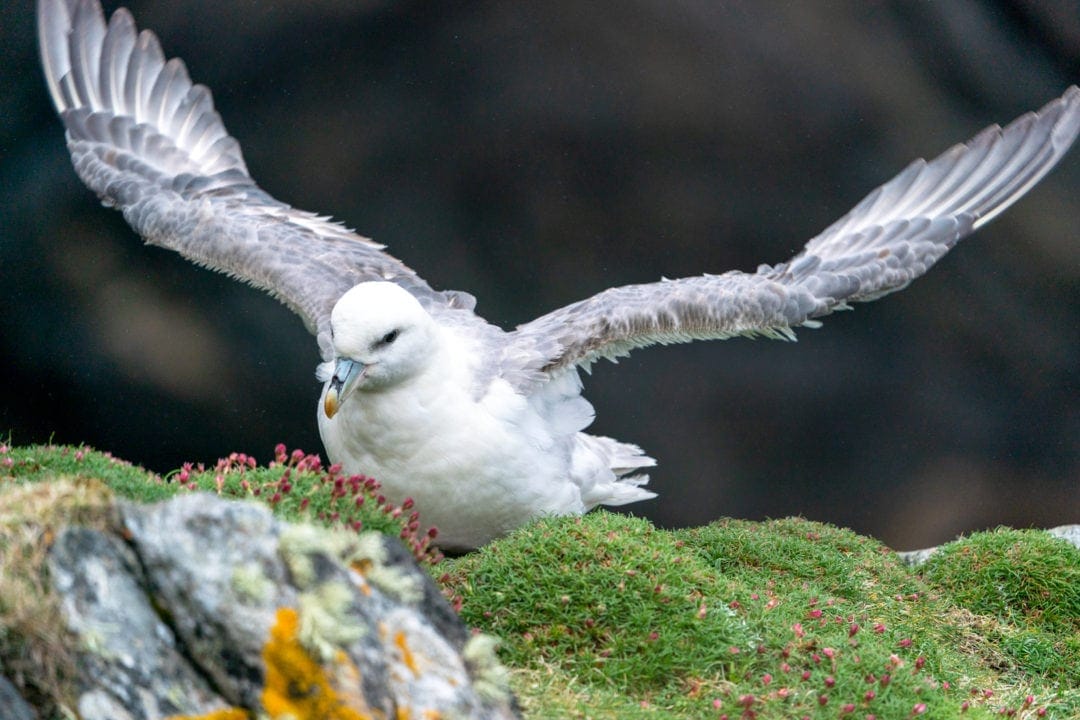
Food and Drink in the Outer Hebrides
One of the most talked-about specialities of the island is Stornoway black pudding. You haven’t experienced real island life unless you’ve tried this, even if it’s just a small bite.
This was me. Because although Lars was wolfing his black pudding down and seemingly enjoying every bit, I wasn’t so keen on sampling oats, beef fat and fresh pig’s blood.
Seaweed also plays a part in the island’s culinary flavours as well as in some of its gin production. The local peat is used to smoke an array of seafood, and the island has its fair share of whisky and gin distilleries.
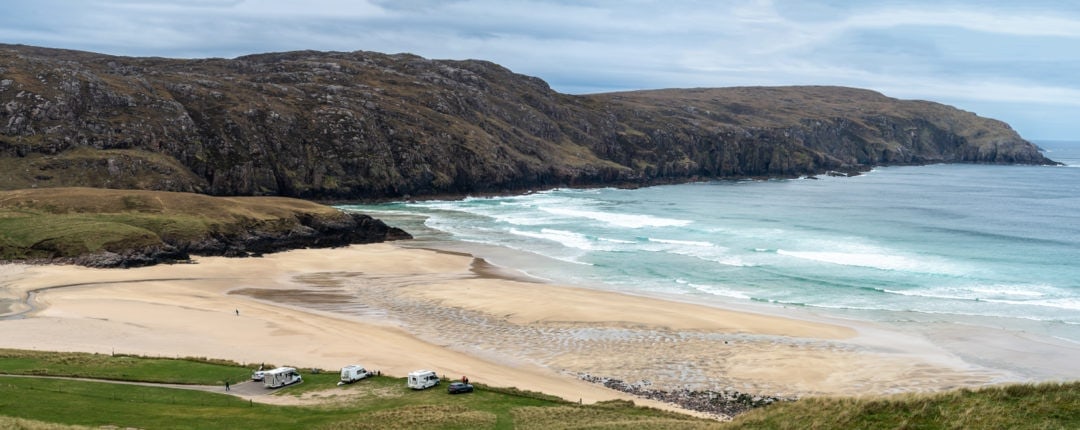
Driving the Outer Hebrides … That’s a Wrap
In this article, we’ve included a large amount of information for an Outer Hebrides Scotland road trip and things to do on Lewis and Harris.
We hope this helps in planning your own road trip and that the photos and snippets of information give you an idea of what you’d like to include in your Outer Hebrides itinerary.
We’d love to hear from you if you find this helpful, and do tell us about your trip.
You can download a FREE road trip planner here to help make your journey more organised and stress-free.

Pin and Save for Later

Read More:
- Ultimate Scotland Travel Guide
- Road Tripping in Orkney, Scotland
- Our Favourite Road Trips Through Europe
Planning Your Travels?
These are the travel resources we recommend and use when planning our trips.
- 🚘 Car Hire: We use DiscoverCars.com
- Motorhome/Campervan Rental: We highly recommend the Motorhome Republic
- 🪪 Order your International Driver’s Licence online here
- 🛏 Book Accommodation: We use Booking.com to find accommodation that suits our budget
- 🐶 Pet Sitting/Pet Sitters: Check Out TrustedHousesitters here (Use our Discount code: LIFEJOURNEY25 for 25% off. )
- Activities and Experiences: Get Your Guide and Viator
- Travel Insurance: Safetywing or World Nomads
- 🥾 Travel Gear and Accessories: Check out our top picks here — Lifejourney4two page on Amazon
For a more thorough list, visit our Travel Resources page here.

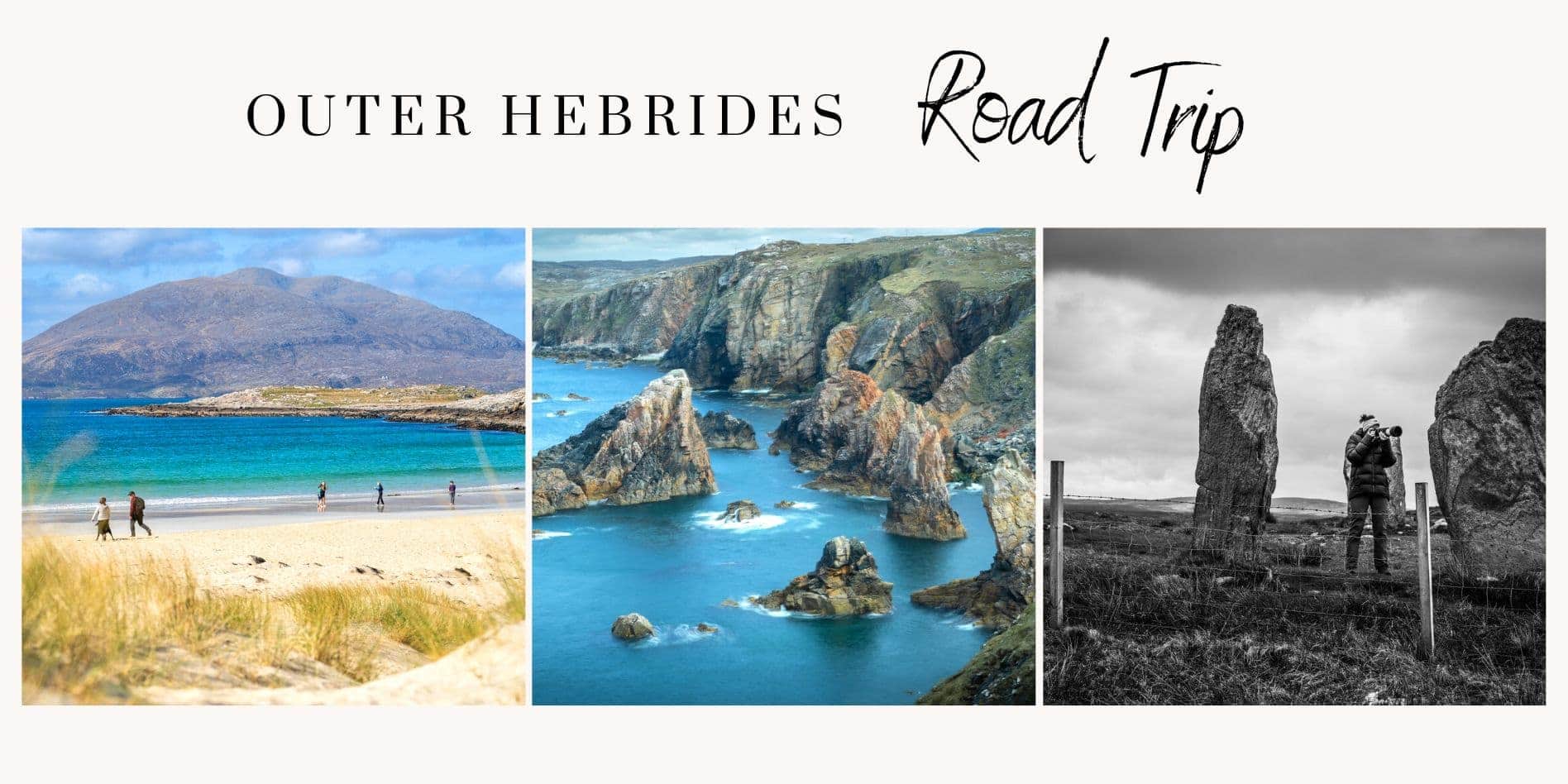
After scratching my head for ages to find a perfect Outer Hebrides Road Trip I stumbled on your masterpiece. Thank you Shelley, I’ve downloaded your guide and will be following it to the letter!
Oh that’s made my day! Thank you Kevin – that’s why we share our travels and I’m so pleased it was just what you were looking for. Let us know how your trip goes – we’d love to hear about it.